Paul van Yperen's Blog, page 297
September 5, 2017
Blanche Montel
Blanche Montel (1902-1998) was a French actress who had a long career in French silent and sound cinema between the 1910s to the 1940s.
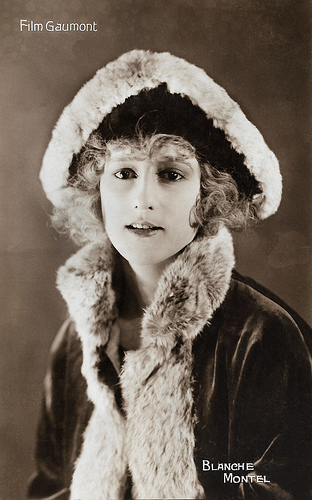
French postcard. Photo: Film Gaumont.
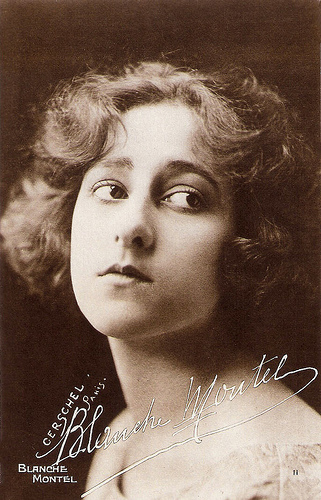
French postcard by Cinémagazine, no. 11. Photo: Gerschell, Paris.
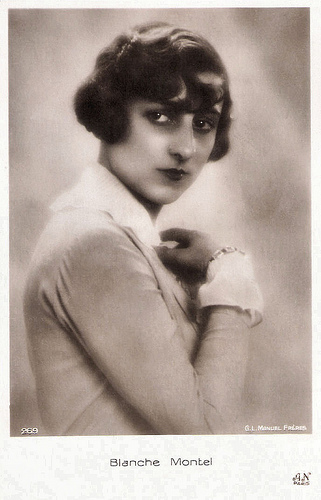
French postcard by A.N., Paris, no. 269. Photo: G.L. Manuel Frères.
Sensibility, Seductiveness and Freshness
Rose Blanche Jeanne Montel was born in Tours, France in 1902. When she was only 11, she was already engaged by filmmaker Alfred Machin to play a young Dutch girl, Kaatje, in La fille de Delft/A Tragedy in the Clouds (Alfred Machin, 1914). The film was shot at the Belgium Pathé studio of Chateau Karreveld at Molenbeek-Saint-Jean near Brussels.
Montel then worked in scenography until she met Gaumont film director Louis Feuillade, who was impressed by her sensibility, her seductiveness and her freshness. He directed her in various short films but also in long running serials like Barrabas (1919) with Édouard Mathé , Les deux gamines/The Two Girls (1921), and L'orpheline/The orphan (1921), often starring Sandra Milovanoff.
From the early 1920s on, Montel had leading parts in La fille des chiffoniers/The Girl of the Dust Bin (Henri Desfontaines, 1922), Son altesse/Her Higness (Henri Desfontaines, 1923), and Une vieille marquise très riche/An old very rich marchioness (Emilien Champetier, 1923).
It was followed by L'éveilleur d'instincts/The awakening of instincts(Emilien Champetier, 1925) with Armand Bernard , La vocation d'André Carel/The Vocation of André Carel (Jean Choux, 1925) with Michel Simon , Le roi de la pédale/King of the pedal (Maurice Champreux, 1925), and her last silent film La ronde infernale/The infernal round (Luitz-Morat, 1928) starring Jean Angelo .
Montel's first sound film was L'Arlésienne (Jacques de Baroncelli, 1930) and she remained quite active in the early 1930s in films such as the comedy Flagrant délit/Flagrante delicto (Hanns Schwarz, George Tréville, 1931), Clair de lune/Moonlight (Henri Diamant-Berger, 1932) with Henri Garat , and the drama L'enfant du miracle/The Miracle Child (D.B. Maurice, 1932).
Then followed parts in Miquette et sa mère/Miquette and Her Mother (Diamant-Berger, 1933) with Montel as Miquette, Les bleus du ciel/The Blue Ones of the Sky (Henri Decoin, 1933) with Albert Préjean, and La maison du mystère/The house of the mystery (Gaston Roudès, 1933).
In Les trois mousquetaires/The Three Musketeers (Henri Diamant-Berger, 1933, she played Constance opposite Aimé Simon-Girard as D'Artganan. Other films were L'aventurier/The Adventurer (Marcel L'Herbier, 1934) starring Victor Francen , and Durand bijoutier/Durand Jeweller (Jean Stelli, 1938). In addition to these films Montel played smaller roles in various French films of the 1920s and 1930s. In those two decades she was also an acclaimed stage actress.
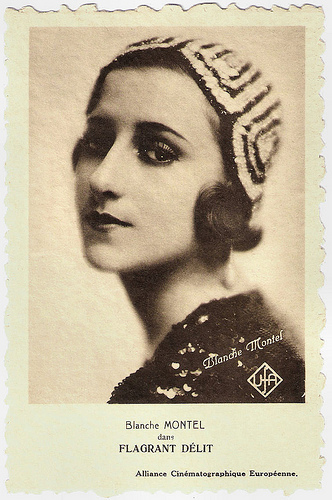
Belgian postcard by Nels / Ern. Thill, Bruxelles / Alliance Cinematographiques Européenne. Photo: Ufa. Publicity still for Flagrant Délit (Hanns Schwarz, Georges Tréville, 1931). Flagrant Délit was an alternate-language version of Einbrecher/Burglars (Hanns Schwarz, 1930) with Lilian Harvey and Willy Fritsch .
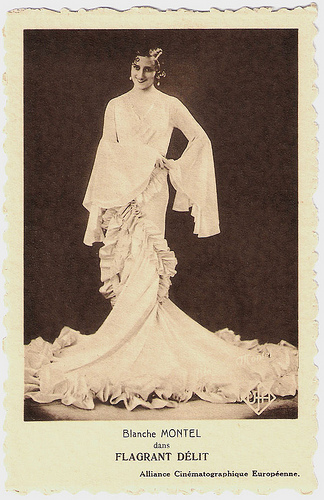
French postcard by Nels / Alliance Cinématographiques Européenne. Photo: Ufa. Publicity still for Flagrant Délit (Hanns Schwarz, Georges Tréville, 1931).
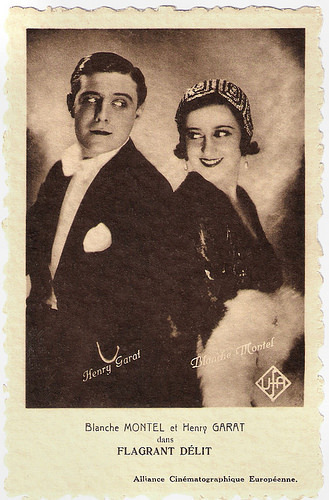
French postcard by Nels / Alliance Cinématographiques Européenne. Photo: Ufa. Publicity still with Blanche Montel and Henri Garat in Flagrant Délit (Hanns Schwarz, Georges Tréville, 1931).
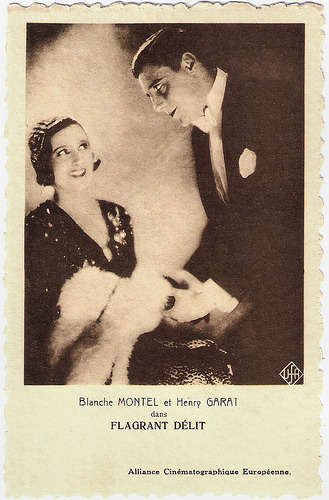
French postcard by Nels / Alliance Cinématographiques Européenne. Photo: Ufa. Publicity still with Blanche Montel and Henri Garat in Flagrant Délit (Hanns Schwarz, Georges Tréville, 1931).
The Beautiful Nivernaise
A highlight among her silent films was La belle Nivernaise/The Beauty from Nivernais (Jean Epstein, 1924).I
n the documentary series Cinema Europe: The Other Hollywood (1995), Kevin Brownlow and David Gill interviewed Blanche Montel. She tells ironically how surprised she was, that after she was asked to play the female lead in La belle Nivernaise, she found out that the Nivernaise was not a beautiful young girl but a very old and ugly boat.
This quite naturalist film on life aboard a barge precedes Jean Vigo's better known L' Atalante.
Between 1927 and 1934 Montel was married to film director Henri Decoin, but she did not play in many of his films.
In the early 1930s she played more often in films by Henri Diamant-Berger. Montel and Decoin had one son, Jacques (1928-1998). After she had divorced Henri Decoin she had an affair with Jean-Pierre Aumont , until 1940 when Aumont fled to the United States.
Blanche Montel's last performance was that of Madame Brown in a film by her ex-husband, L' Homme de Londres/The London Man (Henri Decoin, 1943), a Georges Simenon adaptation. In 1946 she started a new career as an impresario for artists.
After her son Jacques died in 1998, Blanche Montel soon also passed away in 1999 in Luzarches, at the high age of 95.
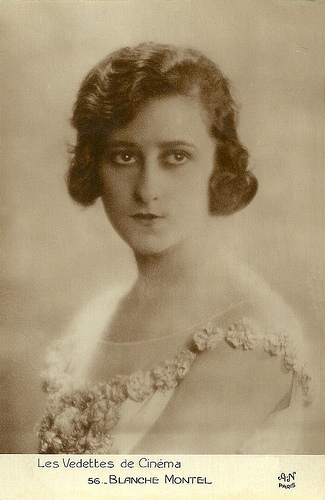
French postcard by A.N., Paris, in the series Les Vedettes de Cinéma, no. 56.
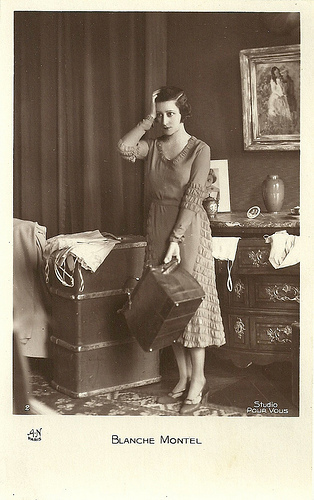
French postcard by A.N., Paris, no. 2. Photo: Studio Pour Vous.
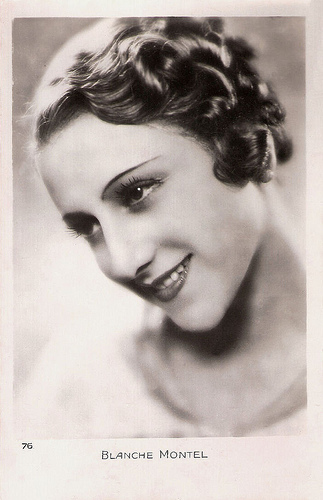
French postcard, no. 75.
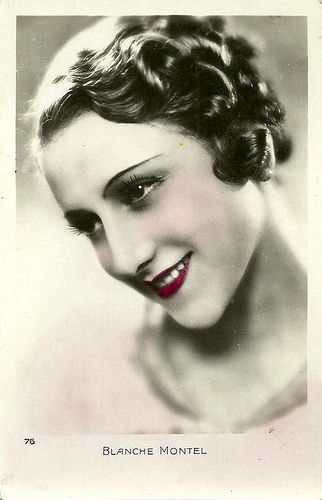
French postcard, no. 76.
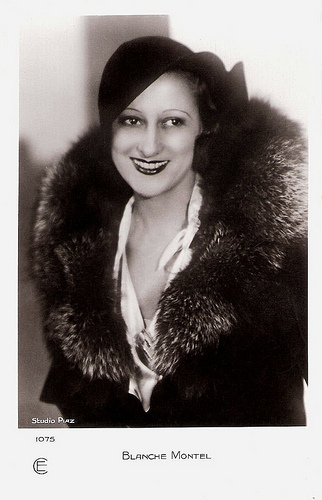
French postcard by Cinémagazine-Édition, Paris, no. 1075. Photo: Studio Piaz.
Sources: Wikipedia (French), Cinememorial, CinéArtistes and .

French postcard. Photo: Film Gaumont.

French postcard by Cinémagazine, no. 11. Photo: Gerschell, Paris.

French postcard by A.N., Paris, no. 269. Photo: G.L. Manuel Frères.
Sensibility, Seductiveness and Freshness
Rose Blanche Jeanne Montel was born in Tours, France in 1902. When she was only 11, she was already engaged by filmmaker Alfred Machin to play a young Dutch girl, Kaatje, in La fille de Delft/A Tragedy in the Clouds (Alfred Machin, 1914). The film was shot at the Belgium Pathé studio of Chateau Karreveld at Molenbeek-Saint-Jean near Brussels.
Montel then worked in scenography until she met Gaumont film director Louis Feuillade, who was impressed by her sensibility, her seductiveness and her freshness. He directed her in various short films but also in long running serials like Barrabas (1919) with Édouard Mathé , Les deux gamines/The Two Girls (1921), and L'orpheline/The orphan (1921), often starring Sandra Milovanoff.
From the early 1920s on, Montel had leading parts in La fille des chiffoniers/The Girl of the Dust Bin (Henri Desfontaines, 1922), Son altesse/Her Higness (Henri Desfontaines, 1923), and Une vieille marquise très riche/An old very rich marchioness (Emilien Champetier, 1923).
It was followed by L'éveilleur d'instincts/The awakening of instincts(Emilien Champetier, 1925) with Armand Bernard , La vocation d'André Carel/The Vocation of André Carel (Jean Choux, 1925) with Michel Simon , Le roi de la pédale/King of the pedal (Maurice Champreux, 1925), and her last silent film La ronde infernale/The infernal round (Luitz-Morat, 1928) starring Jean Angelo .
Montel's first sound film was L'Arlésienne (Jacques de Baroncelli, 1930) and she remained quite active in the early 1930s in films such as the comedy Flagrant délit/Flagrante delicto (Hanns Schwarz, George Tréville, 1931), Clair de lune/Moonlight (Henri Diamant-Berger, 1932) with Henri Garat , and the drama L'enfant du miracle/The Miracle Child (D.B. Maurice, 1932).
Then followed parts in Miquette et sa mère/Miquette and Her Mother (Diamant-Berger, 1933) with Montel as Miquette, Les bleus du ciel/The Blue Ones of the Sky (Henri Decoin, 1933) with Albert Préjean, and La maison du mystère/The house of the mystery (Gaston Roudès, 1933).
In Les trois mousquetaires/The Three Musketeers (Henri Diamant-Berger, 1933, she played Constance opposite Aimé Simon-Girard as D'Artganan. Other films were L'aventurier/The Adventurer (Marcel L'Herbier, 1934) starring Victor Francen , and Durand bijoutier/Durand Jeweller (Jean Stelli, 1938). In addition to these films Montel played smaller roles in various French films of the 1920s and 1930s. In those two decades she was also an acclaimed stage actress.

Belgian postcard by Nels / Ern. Thill, Bruxelles / Alliance Cinematographiques Européenne. Photo: Ufa. Publicity still for Flagrant Délit (Hanns Schwarz, Georges Tréville, 1931). Flagrant Délit was an alternate-language version of Einbrecher/Burglars (Hanns Schwarz, 1930) with Lilian Harvey and Willy Fritsch .

French postcard by Nels / Alliance Cinématographiques Européenne. Photo: Ufa. Publicity still for Flagrant Délit (Hanns Schwarz, Georges Tréville, 1931).

French postcard by Nels / Alliance Cinématographiques Européenne. Photo: Ufa. Publicity still with Blanche Montel and Henri Garat in Flagrant Délit (Hanns Schwarz, Georges Tréville, 1931).

French postcard by Nels / Alliance Cinématographiques Européenne. Photo: Ufa. Publicity still with Blanche Montel and Henri Garat in Flagrant Délit (Hanns Schwarz, Georges Tréville, 1931).
The Beautiful Nivernaise
A highlight among her silent films was La belle Nivernaise/The Beauty from Nivernais (Jean Epstein, 1924).I
n the documentary series Cinema Europe: The Other Hollywood (1995), Kevin Brownlow and David Gill interviewed Blanche Montel. She tells ironically how surprised she was, that after she was asked to play the female lead in La belle Nivernaise, she found out that the Nivernaise was not a beautiful young girl but a very old and ugly boat.
This quite naturalist film on life aboard a barge precedes Jean Vigo's better known L' Atalante.
Between 1927 and 1934 Montel was married to film director Henri Decoin, but she did not play in many of his films.
In the early 1930s she played more often in films by Henri Diamant-Berger. Montel and Decoin had one son, Jacques (1928-1998). After she had divorced Henri Decoin she had an affair with Jean-Pierre Aumont , until 1940 when Aumont fled to the United States.
Blanche Montel's last performance was that of Madame Brown in a film by her ex-husband, L' Homme de Londres/The London Man (Henri Decoin, 1943), a Georges Simenon adaptation. In 1946 she started a new career as an impresario for artists.
After her son Jacques died in 1998, Blanche Montel soon also passed away in 1999 in Luzarches, at the high age of 95.

French postcard by A.N., Paris, in the series Les Vedettes de Cinéma, no. 56.

French postcard by A.N., Paris, no. 2. Photo: Studio Pour Vous.

French postcard, no. 75.

French postcard, no. 76.

French postcard by Cinémagazine-Édition, Paris, no. 1075. Photo: Studio Piaz.
Sources: Wikipedia (French), Cinememorial, CinéArtistes and .
Published on September 05, 2017 22:00
September 4, 2017
New and rare from Didier Hanson
Regularly, postcard collector Didier Hanson sends scans of his new acquisitions to EFSP. This time he found one-century-old Russian postcards of the young and unforgettable Vera Kholodnaya. Earlier Didier has sent us postcards of German actress Maria Orska and of legendary Russian Opera singer Feodor Chaliapin.
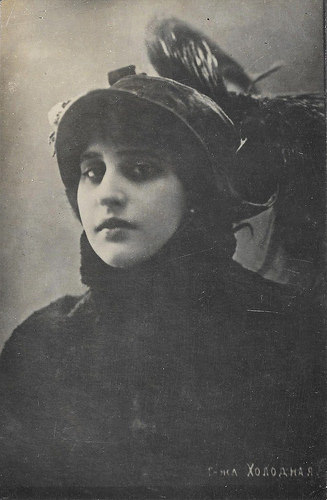
Vera Kholodnaya. Russian postcard. Collection: Didier Hanson.
Vera Kholodnaya. (1893-1919) was the first star of the Russian silent cinema. Only 26, the ‘Queen of Screen’ died of the Spanish flu during the pandemic of 1919. Although she worked only three years for the cinema, she must have made some forty short and feature films. The Soviet authorities ordered to destroy many of the Kholodnaya features in 1924, and only five of her films still exist.
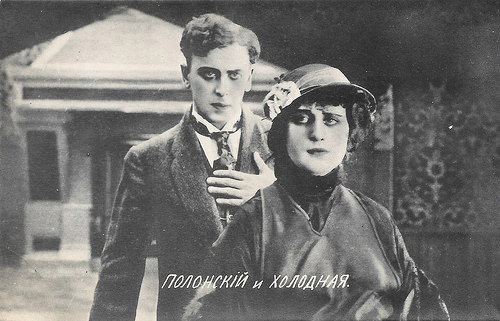
Vera Kholodnaya and Vitold Polonsky . Russian postcard. Collection: Didier Hanson.
Vitold Polonsky (1879-1919) was one of the most popular actors in pre-Revolutionary Russian cinema.
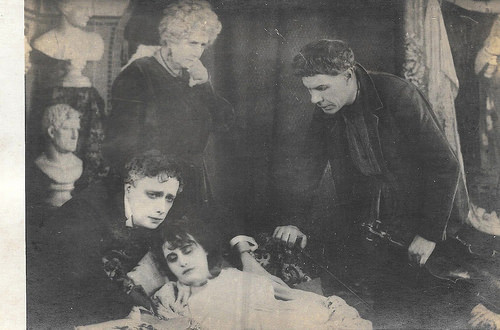
Vera Kholodnaya ,Vladimir Maksimov, Olga Rakhmanova and Pyotr Chardynin in Molchi, grust'... molchi/Still, Sadness... Still... (Pyotr Chardynin, Cheslav Sabinsky, 1918). Russian postcard. Collection: Didier Hanson.
This is probably the final scene of Molchi, grust'... molchi/Still, Sadness... Still... (Pyotr Chardynin, Kharitonov, 1917). The alternative title is A Tale of Precious Love (Skazka lyubve dorogoi). The card depicts the final scene where Paola ( Vera Kholodnaya ) dies - which the Russian press compared to the death of Trilby. She is surrounded on the right by her partner, the musical clown Lorio (Pyotr Chardynin), and by her lover, the painter Volyntsev (Vladimir Maksimov), on the left. In the back the painter's mother (Olga Rakhmanova). The statues refer to the artist's studio. Only the first part of this film survives. At the time it was a huge success in Russia.
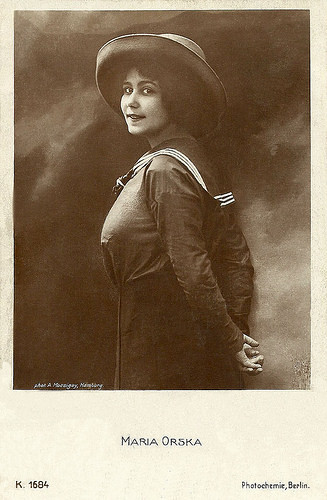
Maria Orska. German postcard by Photochemie no. K 1684. Photo: Mocsigay, Hamburg. Collection: Didier Hanson.
Maria Orska (1893-1930) was a Russian-Jewish actress of the German stage and screen in the 1910s and 1920s.
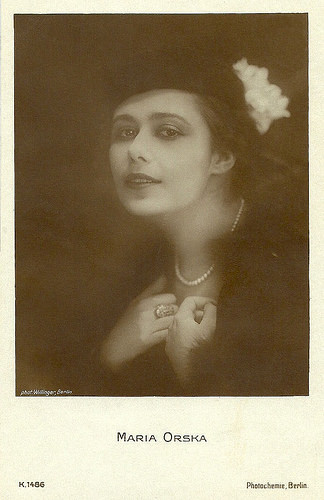
Maria Orska. German postcard by Photochemie, no. K 1486. Photo: Willnger, Berlin. Collection: Didier Hanson.
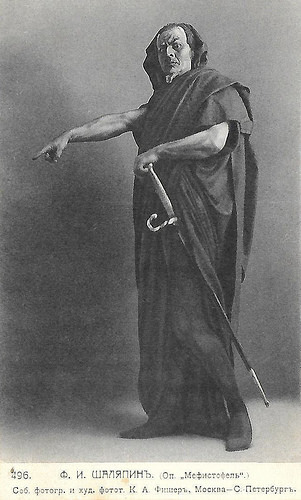
Feodor Chaliapin as Mephisto. Russian postcard, no. 496. Photo: publicity still for the stage production of Arrigo Boito's opera Mefistofele. Collection: Didier Hanson.
Feodor Ivanovich Chaliapin (Russian: Фёдор Ива́нович Шаля́пин) (1873–1938) was a Russian opera singer. The possessor of a large, deep and expressive bass voice, he enjoyed an important international career at major opera houses and is often credited with establishing the tradition of naturalistic acting in his chosen art form.
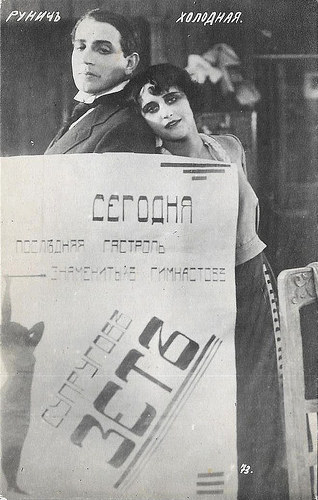
Ossip Runitsch and Vera Kholodnaya . Russian postcard, no. 73. Collection: Didier Hanson.
Russian actor, producer and stage director Ossip Runitsch (1889-1947) was one of the biggest stars of Russian silent cinema and one of the first iconic figures of Russian cinematograph.
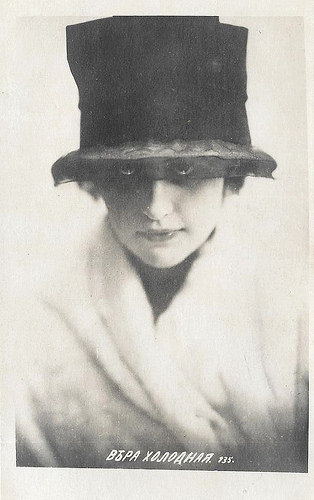
Vera Kholodnaya . Russian postcard, no. 135. Collection: Didier Hanson.
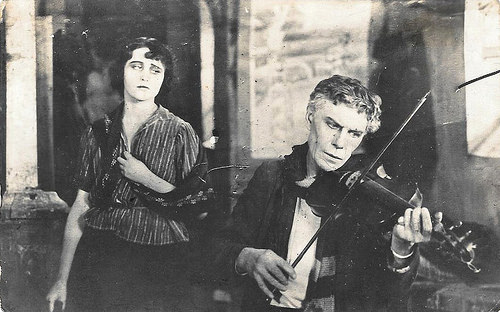
Vera Kholodnaya . Russian postcard. Collection: Didier Hanson.
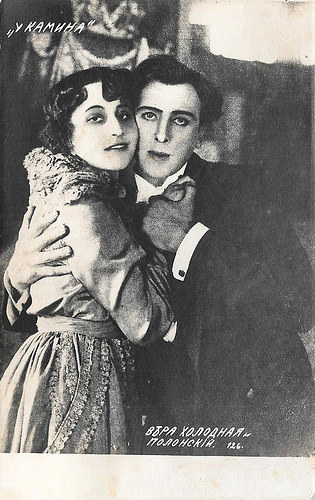
Vera Kholodnaya and Vitold Polonsky in U kamina (1917). Russian postcard, no. 126. Photo: publicity still for U kamina/By the fireplace (Pyotr Chardynin, 1917). Collection: Didier Hanson.
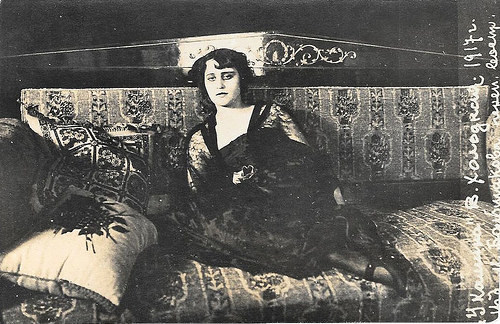
Vera Kholodnaya , 1917. Russian postcard, 1917. Collection: Didier Hanson.
Thanks, Didier!
Sources Yuri Tsivian (Silent Witnesses: Russian Films 1908-1919) and IMDb.

Vera Kholodnaya. Russian postcard. Collection: Didier Hanson.
Vera Kholodnaya. (1893-1919) was the first star of the Russian silent cinema. Only 26, the ‘Queen of Screen’ died of the Spanish flu during the pandemic of 1919. Although she worked only three years for the cinema, she must have made some forty short and feature films. The Soviet authorities ordered to destroy many of the Kholodnaya features in 1924, and only five of her films still exist.

Vera Kholodnaya and Vitold Polonsky . Russian postcard. Collection: Didier Hanson.
Vitold Polonsky (1879-1919) was one of the most popular actors in pre-Revolutionary Russian cinema.

Vera Kholodnaya ,Vladimir Maksimov, Olga Rakhmanova and Pyotr Chardynin in Molchi, grust'... molchi/Still, Sadness... Still... (Pyotr Chardynin, Cheslav Sabinsky, 1918). Russian postcard. Collection: Didier Hanson.
This is probably the final scene of Molchi, grust'... molchi/Still, Sadness... Still... (Pyotr Chardynin, Kharitonov, 1917). The alternative title is A Tale of Precious Love (Skazka lyubve dorogoi). The card depicts the final scene where Paola ( Vera Kholodnaya ) dies - which the Russian press compared to the death of Trilby. She is surrounded on the right by her partner, the musical clown Lorio (Pyotr Chardynin), and by her lover, the painter Volyntsev (Vladimir Maksimov), on the left. In the back the painter's mother (Olga Rakhmanova). The statues refer to the artist's studio. Only the first part of this film survives. At the time it was a huge success in Russia.

Maria Orska. German postcard by Photochemie no. K 1684. Photo: Mocsigay, Hamburg. Collection: Didier Hanson.
Maria Orska (1893-1930) was a Russian-Jewish actress of the German stage and screen in the 1910s and 1920s.

Maria Orska. German postcard by Photochemie, no. K 1486. Photo: Willnger, Berlin. Collection: Didier Hanson.

Feodor Chaliapin as Mephisto. Russian postcard, no. 496. Photo: publicity still for the stage production of Arrigo Boito's opera Mefistofele. Collection: Didier Hanson.
Feodor Ivanovich Chaliapin (Russian: Фёдор Ива́нович Шаля́пин) (1873–1938) was a Russian opera singer. The possessor of a large, deep and expressive bass voice, he enjoyed an important international career at major opera houses and is often credited with establishing the tradition of naturalistic acting in his chosen art form.

Ossip Runitsch and Vera Kholodnaya . Russian postcard, no. 73. Collection: Didier Hanson.
Russian actor, producer and stage director Ossip Runitsch (1889-1947) was one of the biggest stars of Russian silent cinema and one of the first iconic figures of Russian cinematograph.

Vera Kholodnaya . Russian postcard, no. 135. Collection: Didier Hanson.

Vera Kholodnaya . Russian postcard. Collection: Didier Hanson.

Vera Kholodnaya and Vitold Polonsky in U kamina (1917). Russian postcard, no. 126. Photo: publicity still for U kamina/By the fireplace (Pyotr Chardynin, 1917). Collection: Didier Hanson.

Vera Kholodnaya , 1917. Russian postcard, 1917. Collection: Didier Hanson.
Thanks, Didier!
Sources Yuri Tsivian (Silent Witnesses: Russian Films 1908-1919) and IMDb.
Published on September 04, 2017 22:00
September 3, 2017
Estella Blain
Gorgeous Estella Blain (1930-1982) was one of the sexy stars in Brigitte Bardot style of the French cinema of the 1950s. Her career lost steam during the 1960s and her life ended in tragedy.
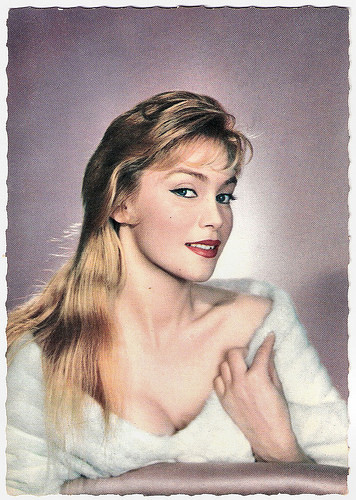
French postcard by Editions du Globe, Paris, no. 41. Photo: Sam Lévin.
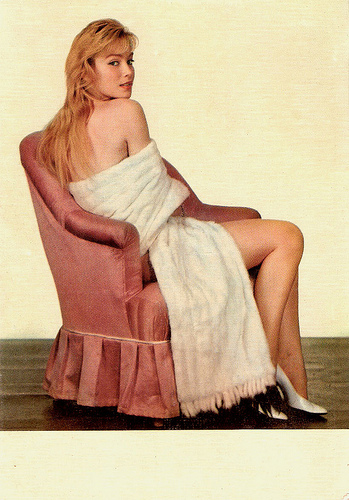
French postcard by Editions P.I., Paris, no. 1027. Photo: Sam Lévin.
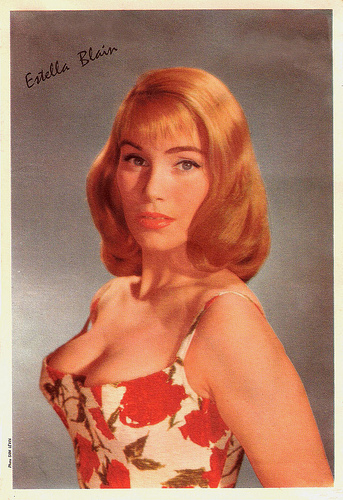
Big vintage card. Photo: Sam Lévin.
Sexy Schoolgirls
Estella Blain was born as Micheline Estellat in Paris in 1930.
In 1953 she married the actor Gérard Blain . The following year they appeared together in the film Les fruits sauvages/Wild Fruit (Hervé Bromberger, 1954). She played a young girl who accidentally kills her alcoholic father and with a group of rebellious youngsters she finds refuge in an old, deserted village. Estella and Gérard divorced in 1956, but she kept his name.
She played one of the sexy schoolgirls in Les collégiennes/The Twilight Girls (André Hunebelle, 1957) with Agnès Laurent and Catherine Deneuve in her first, small film role.
Blain worked again with director Hervé Bromberger at La bonne tisane/Good Medicine (Hervé Bromberger, 1958) in which she played a young idealistic nurse on her first tour of duty, who is horrified by the carelessness of her colleagues and the doctors.
She was quite busy in this period. In the routine spy thriller Le fauve est lâché/The Beast Is Loose (Maurice Labro, 1959) she starred opposite tough guy Lino Ventura . In Les dragueurs/The Chasers (Jean-Pierre Mocky, 1959), she was one of the girls chased by Jacques Charrier and Charles Aznavour .
In the thriller Des femmes disparaissent/The Road to Shame (Edouard Molinaro, 1959) she played a victim of white-slave trade who is saved by her car mechanic fiance, played by Robert Hossein . At Films de France , James Travers reviews: “an all too obvious imitation of the American gangster movie, although Molinaro does manage to evoke the essence of classic film noir very effectively in some sequences. The problem with the film is that it is too much of a pastiche, with very little substance to it – no real characterisation, a threadbare plot, and interminable, badly choreographed, fight scenes. On the plus side, Art Blakey’s marvellous jazz score gives the film a touch of stylish modernity, an innovation which thriller directors of the time were quick to emulate”.
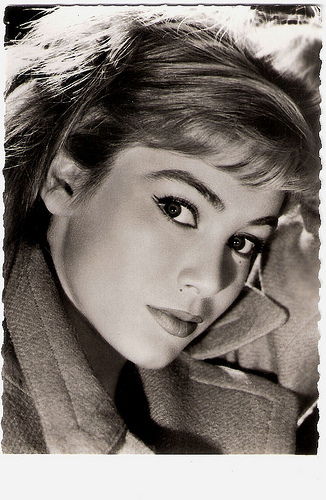
French postcard by Editions P.I., Paris, no. 977. Offered by Les Carbones Korès Carboplane. Photo: Sam Lévin.
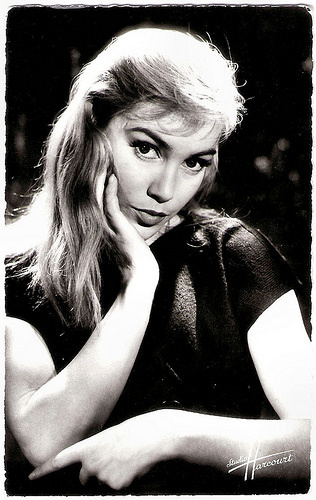
French postcard by Editions du Globe, Paris, no. 703. Photo: Studio Harcourt.
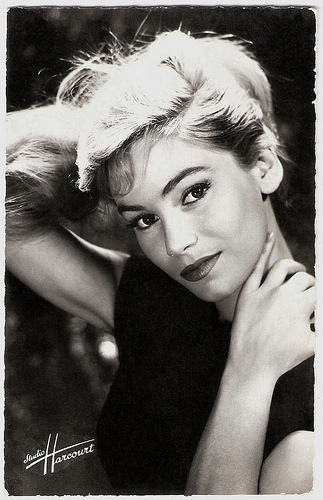
French postcard by Editions du Globe, Paris, no. 802. Photo: Studio Harcourt.
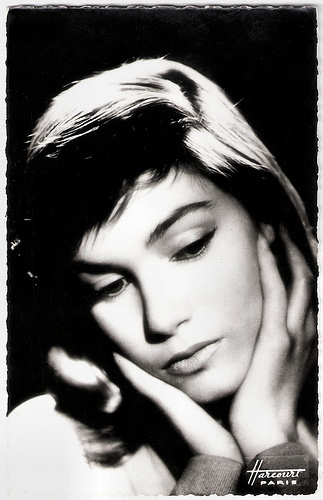
French postcard. Photo Studio Harcourt, Paris.
A Zombie-like Killing Machine
In 1959 Estella Blain also had a son, Michel Blain-Estellat, who later became an actor and director. For him she wrote the series Un enfant nommé Michel/A child named Michael in which he performed the title role.
During the 1960s, her film career went downhill. She played in such mediocre international productions as the Italian adventure film I pirati della costa/Pirates of the Coast (Domenico Paolella, 1960) starring Lex Barker , and the German operetta Im weißen Rößl/The White Horse Inn (Werner Jacobs, 1960) starring Peter Alexander .
Her best known role was a supporting part as the poisonous Madame De Montespan in Angélique et le roy/Angelique and the King (Bernard Borderie, 1966), the third in the series of five films adapted from the stories by Anne and Serge Golon featuring Michèle Mercier .
As a singer she had two melancholic hit songs in 1965, Solitude (Dim Dam Dom) and Il ne faut pas (It is not necessary), which she had both written and composed herself. Blain also played a singer in the dark, surrealistic horror film Miss Muerte/The Diabolical Dr. Z (Jesus Franco, 1966). Miss Muerte is an exotic dancer who becomes a zombie-like killing machine, who lures and kills victims with razor-sharp and poisoned fingernails while clad in a skull-mask and a revealing bodysuit.
At IMDb, reviewer Jens Kofoed-Pihl names it “one of the best, creepiest and most stylish from the Godfather of Eurosleaze” (cult film maker Jesus Franco) and “a masterpiece of the macabre!” Robert Pirsching at AllMovie calls it “One of Franco's most entertaining films”.
However, at the end of the decade Blain was only incidentally seen on TV and in the theatre, although she had a small part in the film comedy A Flea in Her Ear (Jacques Charon, 1968) starring Rex Harrison . Her last film role was in the dark satire Le mouton enragé/Love at the Top (Michel Deville, 1974) starring Jean-Louis Trintignant and Romy Schneider .
Estella Blain died on 1 January 1982 in her home in Port-Vendres, France. Lonesome and depressed about the failure of her film career she committed suicide with a gunshot. She was only 51.
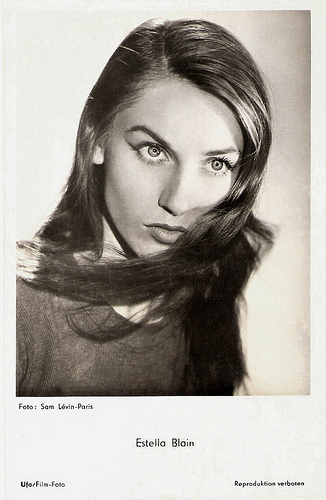
German postcard by Ufa, Berlin-Tempelhof, no. FK 1085. Photo: Sam Lévin, Paris.
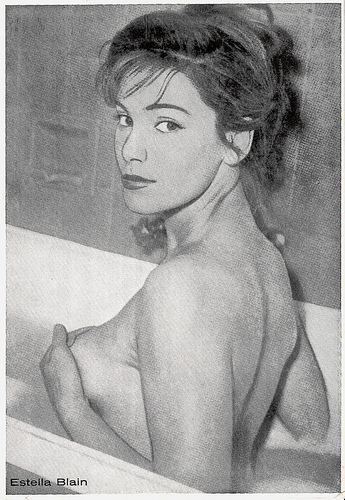
Vintage card.
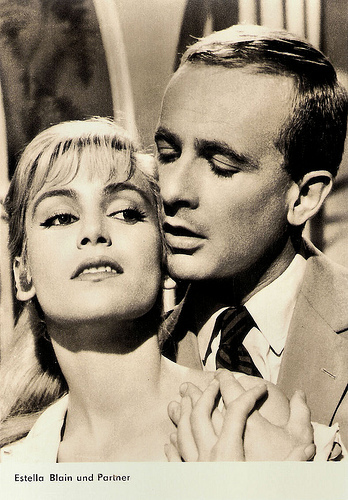
East-German postcard by VEB Progress Filmvertrieb, Berlin, no. 2964, 1967. Photo: publicity still for Le fauve est lâché/The Beast Is Loose (Maurice Labro, 1959) with Estella Blain and Philippe Mareuil.
Trailer of The Diabolical Dr Z (1966). Source: MontagTheMagician (YouTube).
Estella Blain sings Solitude (1968). Source: Orgasmo Sonoro (YouTube).
Sources: James Travers (Films de France), Robert Firsching (AllMovie), DB du Monteil (IMDb), Jens Kofoed-Pihl (IMDb), Wikipedia (French) and .

French postcard by Editions du Globe, Paris, no. 41. Photo: Sam Lévin.

French postcard by Editions P.I., Paris, no. 1027. Photo: Sam Lévin.

Big vintage card. Photo: Sam Lévin.
Sexy Schoolgirls
Estella Blain was born as Micheline Estellat in Paris in 1930.
In 1953 she married the actor Gérard Blain . The following year they appeared together in the film Les fruits sauvages/Wild Fruit (Hervé Bromberger, 1954). She played a young girl who accidentally kills her alcoholic father and with a group of rebellious youngsters she finds refuge in an old, deserted village. Estella and Gérard divorced in 1956, but she kept his name.
She played one of the sexy schoolgirls in Les collégiennes/The Twilight Girls (André Hunebelle, 1957) with Agnès Laurent and Catherine Deneuve in her first, small film role.
Blain worked again with director Hervé Bromberger at La bonne tisane/Good Medicine (Hervé Bromberger, 1958) in which she played a young idealistic nurse on her first tour of duty, who is horrified by the carelessness of her colleagues and the doctors.
She was quite busy in this period. In the routine spy thriller Le fauve est lâché/The Beast Is Loose (Maurice Labro, 1959) she starred opposite tough guy Lino Ventura . In Les dragueurs/The Chasers (Jean-Pierre Mocky, 1959), she was one of the girls chased by Jacques Charrier and Charles Aznavour .
In the thriller Des femmes disparaissent/The Road to Shame (Edouard Molinaro, 1959) she played a victim of white-slave trade who is saved by her car mechanic fiance, played by Robert Hossein . At Films de France , James Travers reviews: “an all too obvious imitation of the American gangster movie, although Molinaro does manage to evoke the essence of classic film noir very effectively in some sequences. The problem with the film is that it is too much of a pastiche, with very little substance to it – no real characterisation, a threadbare plot, and interminable, badly choreographed, fight scenes. On the plus side, Art Blakey’s marvellous jazz score gives the film a touch of stylish modernity, an innovation which thriller directors of the time were quick to emulate”.

French postcard by Editions P.I., Paris, no. 977. Offered by Les Carbones Korès Carboplane. Photo: Sam Lévin.

French postcard by Editions du Globe, Paris, no. 703. Photo: Studio Harcourt.

French postcard by Editions du Globe, Paris, no. 802. Photo: Studio Harcourt.

French postcard. Photo Studio Harcourt, Paris.
A Zombie-like Killing Machine
In 1959 Estella Blain also had a son, Michel Blain-Estellat, who later became an actor and director. For him she wrote the series Un enfant nommé Michel/A child named Michael in which he performed the title role.
During the 1960s, her film career went downhill. She played in such mediocre international productions as the Italian adventure film I pirati della costa/Pirates of the Coast (Domenico Paolella, 1960) starring Lex Barker , and the German operetta Im weißen Rößl/The White Horse Inn (Werner Jacobs, 1960) starring Peter Alexander .
Her best known role was a supporting part as the poisonous Madame De Montespan in Angélique et le roy/Angelique and the King (Bernard Borderie, 1966), the third in the series of five films adapted from the stories by Anne and Serge Golon featuring Michèle Mercier .
As a singer she had two melancholic hit songs in 1965, Solitude (Dim Dam Dom) and Il ne faut pas (It is not necessary), which she had both written and composed herself. Blain also played a singer in the dark, surrealistic horror film Miss Muerte/The Diabolical Dr. Z (Jesus Franco, 1966). Miss Muerte is an exotic dancer who becomes a zombie-like killing machine, who lures and kills victims with razor-sharp and poisoned fingernails while clad in a skull-mask and a revealing bodysuit.
At IMDb, reviewer Jens Kofoed-Pihl names it “one of the best, creepiest and most stylish from the Godfather of Eurosleaze” (cult film maker Jesus Franco) and “a masterpiece of the macabre!” Robert Pirsching at AllMovie calls it “One of Franco's most entertaining films”.
However, at the end of the decade Blain was only incidentally seen on TV and in the theatre, although she had a small part in the film comedy A Flea in Her Ear (Jacques Charon, 1968) starring Rex Harrison . Her last film role was in the dark satire Le mouton enragé/Love at the Top (Michel Deville, 1974) starring Jean-Louis Trintignant and Romy Schneider .
Estella Blain died on 1 January 1982 in her home in Port-Vendres, France. Lonesome and depressed about the failure of her film career she committed suicide with a gunshot. She was only 51.

German postcard by Ufa, Berlin-Tempelhof, no. FK 1085. Photo: Sam Lévin, Paris.

Vintage card.

East-German postcard by VEB Progress Filmvertrieb, Berlin, no. 2964, 1967. Photo: publicity still for Le fauve est lâché/The Beast Is Loose (Maurice Labro, 1959) with Estella Blain and Philippe Mareuil.
Trailer of The Diabolical Dr Z (1966). Source: MontagTheMagician (YouTube).
Estella Blain sings Solitude (1968). Source: Orgasmo Sonoro (YouTube).
Sources: James Travers (Films de France), Robert Firsching (AllMovie), DB du Monteil (IMDb), Jens Kofoed-Pihl (IMDb), Wikipedia (French) and .
Published on September 03, 2017 22:00
September 2, 2017
Basil Gill
Handsome British stage actor and film actor Basil Gill (1877-1955) was a popular matinee idol during the 1910s. His stage career included many major roles in plays of William Shakespeare but also in modern plays. Between 1911 and 1938, he also appeared in thirty-five British silent and sound films.
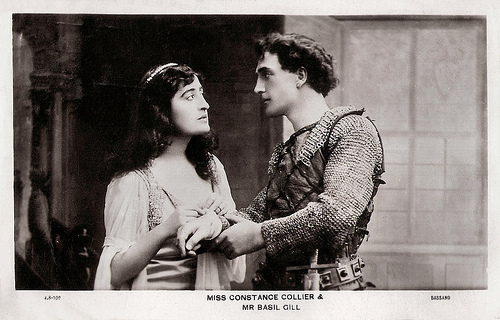
Basil Gill and Constance Collier . British postcard by J.J. Samuels, London, no. 4-8-102. Photo: Bassano.
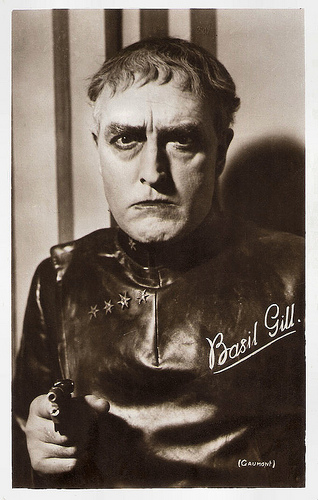
British postcard issued with Sarony Cigarettes, no. 67 of a second series of 42 Cinema Stars. Photo: Gaumont. Publicity still for High Treason (Maurice Elvey, 1929).
The handsomest man on the stage
Basil Gill was born in 1877 in Birkenhead, Cheshire, England. He was a son of the Rev. John Gill, of Cambridge.
For approximately two years until May 1894, he taught art at The Grammar School, Wallington, U.K. before leaving for a post in Switzerland.
His first stage appearance was in The Sign of the Cross, Wilson Barrett's most successful play, in Bury, Lancashire in 1897. The following year he appeared in this play in London. He then toured Australia and the USA with The Sign of the Cross and Ben-Hur. American newspapers called him 'the handsomest man on the stage'.
In 1903 Gill joined Herbert Beerbohm Tree 's company at His Majesty's Theatre, London, and played several important roles in plays of William Shakespeare. He left the company in 1907.
He was regarded as a matinee idol and also played romantic parts in modern plays. But Gill continued to perform in Shakespeare's plays during his career. The accomplished actor received numerous reviews commenting on the clarity and quality of his voice.
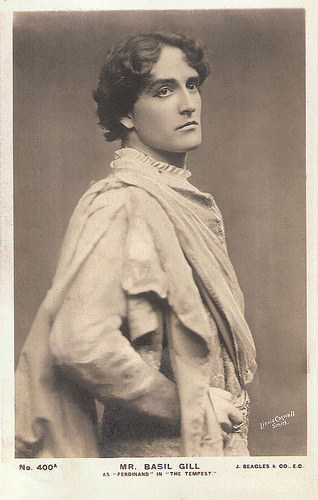
British postcard by Beagles & Co, London, no. 400A. Photo: Lizzie Caswall Smith. Basil Gill as Ferdinand in the play The Tempest by William Shakespeare.
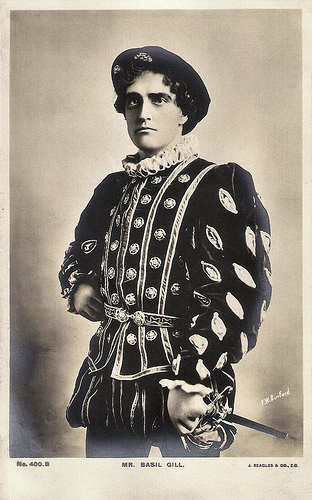
British postcard by Beagles & Co, London, no. 400B. Photo: F.W. Burford.
A mini-boom in Shakespeare adaptations
Basil Gill made his film debut in the silent historical film Henry VIII (Will Barker, 1911). In this film he appeared with Arthur Bourchier and Herbert Beerbohm Tree, on whose version of William Shakespeare and John Fletcher's play the film was based. The film's success sparked a mini-boom in Shakespeare adaptations.
From then on the popular matinee idol played romantic leads and character roles in period drama on screen from 1911. He appeared in such silent films as On the Banks of Allan Water (Wilfred Noy, 1916), the drama Missing the Tide (Walter West, 1918) starring Violet Hopson , and The Rocks of Valpre (Maurice Elvey, 1919).
In 1926, Gill appeared in two short films made in the DeForest Phonofilm sound-on-film process, Santa Claus (George A. Cooper, 1926) as the title character, and Julius Caesar (George A. Cooper, 1926) as Brutus.
He co-starred with Madeleine Carroll in the comedy The School for Scandal (Thorold Dickinson, Maurice Elvey, 1930), the first sound film adaptation of Richard Brinsley Sheridan's play The School for Scandal. It is also the only feature-length film shot using the unsuccessful Raycol colour process.
Gill appeared in many more films, including The Wandering Jew (Maurice Elvey, 1933) starring Conrad Veidt as the Jew who urges Roman authorities to crucify Jesus and release Barabbas. As a punishment, he is condemned by God to wander the Earth for many centuries. His final film was The Citadel (King Vidor, 1938) with Robert Donat .
Basil Gill died in 1955 in Hove, East Sussex, England. He was married to actress Margaret von Cavania.
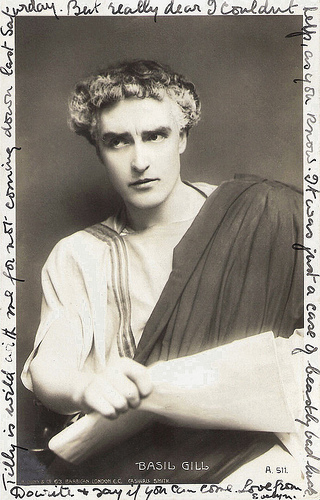
British postcard by H. Dunn & Co, London, no. A. 511. Photo: Caswall Smith.
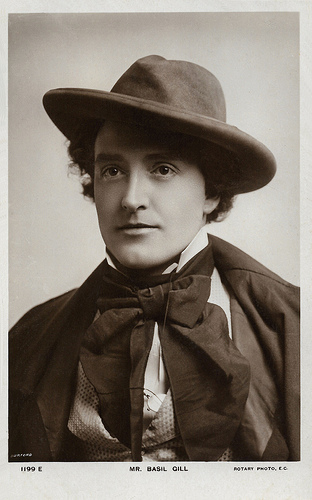
British postcard by Rotary, no. 1199 E. Photo: F.W. Burford.
Sources: Shakespeare & The Players, Wikipedia and .

Basil Gill and Constance Collier . British postcard by J.J. Samuels, London, no. 4-8-102. Photo: Bassano.

British postcard issued with Sarony Cigarettes, no. 67 of a second series of 42 Cinema Stars. Photo: Gaumont. Publicity still for High Treason (Maurice Elvey, 1929).
The handsomest man on the stage
Basil Gill was born in 1877 in Birkenhead, Cheshire, England. He was a son of the Rev. John Gill, of Cambridge.
For approximately two years until May 1894, he taught art at The Grammar School, Wallington, U.K. before leaving for a post in Switzerland.
His first stage appearance was in The Sign of the Cross, Wilson Barrett's most successful play, in Bury, Lancashire in 1897. The following year he appeared in this play in London. He then toured Australia and the USA with The Sign of the Cross and Ben-Hur. American newspapers called him 'the handsomest man on the stage'.
In 1903 Gill joined Herbert Beerbohm Tree 's company at His Majesty's Theatre, London, and played several important roles in plays of William Shakespeare. He left the company in 1907.
He was regarded as a matinee idol and also played romantic parts in modern plays. But Gill continued to perform in Shakespeare's plays during his career. The accomplished actor received numerous reviews commenting on the clarity and quality of his voice.

British postcard by Beagles & Co, London, no. 400A. Photo: Lizzie Caswall Smith. Basil Gill as Ferdinand in the play The Tempest by William Shakespeare.

British postcard by Beagles & Co, London, no. 400B. Photo: F.W. Burford.
A mini-boom in Shakespeare adaptations
Basil Gill made his film debut in the silent historical film Henry VIII (Will Barker, 1911). In this film he appeared with Arthur Bourchier and Herbert Beerbohm Tree, on whose version of William Shakespeare and John Fletcher's play the film was based. The film's success sparked a mini-boom in Shakespeare adaptations.
From then on the popular matinee idol played romantic leads and character roles in period drama on screen from 1911. He appeared in such silent films as On the Banks of Allan Water (Wilfred Noy, 1916), the drama Missing the Tide (Walter West, 1918) starring Violet Hopson , and The Rocks of Valpre (Maurice Elvey, 1919).
In 1926, Gill appeared in two short films made in the DeForest Phonofilm sound-on-film process, Santa Claus (George A. Cooper, 1926) as the title character, and Julius Caesar (George A. Cooper, 1926) as Brutus.
He co-starred with Madeleine Carroll in the comedy The School for Scandal (Thorold Dickinson, Maurice Elvey, 1930), the first sound film adaptation of Richard Brinsley Sheridan's play The School for Scandal. It is also the only feature-length film shot using the unsuccessful Raycol colour process.
Gill appeared in many more films, including The Wandering Jew (Maurice Elvey, 1933) starring Conrad Veidt as the Jew who urges Roman authorities to crucify Jesus and release Barabbas. As a punishment, he is condemned by God to wander the Earth for many centuries. His final film was The Citadel (King Vidor, 1938) with Robert Donat .
Basil Gill died in 1955 in Hove, East Sussex, England. He was married to actress Margaret von Cavania.

British postcard by H. Dunn & Co, London, no. A. 511. Photo: Caswall Smith.

British postcard by Rotary, no. 1199 E. Photo: F.W. Burford.
Sources: Shakespeare & The Players, Wikipedia and .
Published on September 02, 2017 22:00
September 1, 2017
Vom Werden deutscher Filmkunst, Part 5
In the fifth post on Vom Werden deutscher Filmkunst, we focus on what happedned in the German studios like the glass house of the pioneering Eiko film. Pictures of the gigantic forest set for Fritz Lang's Die Nibelungen (1924), of the groundbreaking 'entfesselte kamera' (unchained camera) as used for F.W. Murnau's Der letzte Mann (1924) and of the model for Leni Riefenstahl's Der heilige berg (1926). Ross Verlag published the collectors cards in 1935 for the album Vom Werden deutscher Filmkunst by the 'Cigaretten-Bilderdienst', Altona-Bahrenfeld.
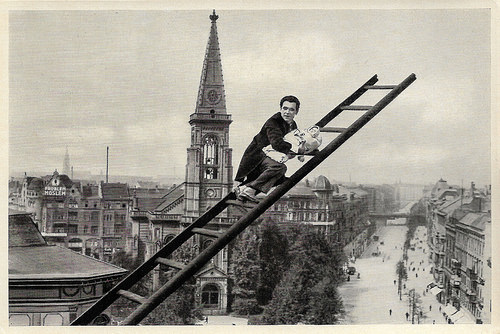
Luciano Albertini in Der Mann auf dem Kometen (1925). German collectors card by Ross Verlag in the series Vom Werden deutscher Filmkunst - Der Stumme Film, no. 129. Photo: Phoebus-Film. Publicity still for Der Mann auf dem Kometen/The Man on the Comet (Alfred Halm, 1925).
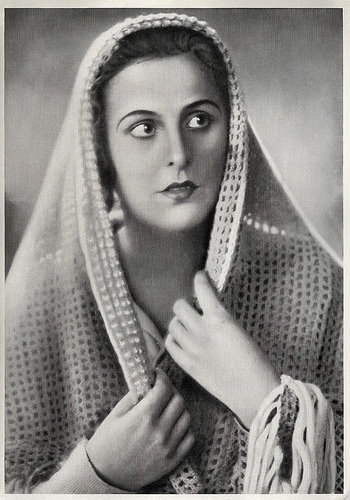
Leni Riefenstahl in Die weiße Hölle vom Piz Palü (1929). German collectors card by Ross Verlag in the series Vom Werden deutscher Filmkunst - Der Stumme Film, picture no. 130, group 40. Photo: Ufa. Publicity still for Die weiße Hölle vom Piz Palü//The White Hell of Piz Palü (Arnold Fanck, G. W. Pabst, 1929).

Wege zu Kraft und Schönheit (1925). German collectors card by Ross Verlag in the series Vom Werden deutscher Filmkunst - Der Stumme Film, picture no, 131, group 43. Photo: Ufa. Publicity still for Wege zu Kraft und Schönheit/Ways to Strength and Beauty (Nicholas Kaufmann, Wilhelm Prager, 1925). Capture: Morgen (Morning).

Max Schreck in Nosferatu (1922). German collectors card by Ross Verlag in the series Vom Werden deutscher Filmkunst - Der Stumme Film, no. 134. Photo: Ufa. Publicity still for the first German horror film, Nosferatu (Friedrich Wilhelm Murnau, 1922).
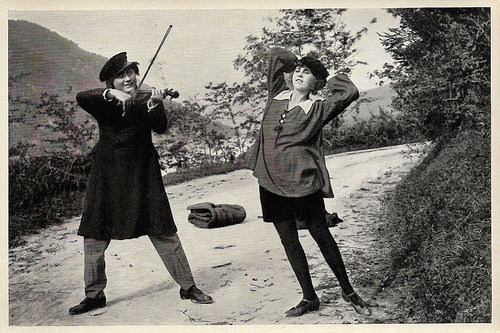
Paul Wegener and Lyda Salmonova in Der verlorene Schatten (1921). German collectors card by Ross Verlag in the series Vom Werden deutscher Filmkunst - Der Stumme Film, no. 134. Photo: Ufa. Publicity still for Der verlorene Schatten/The Lost Shadow (Rochus Gliese, 1921).
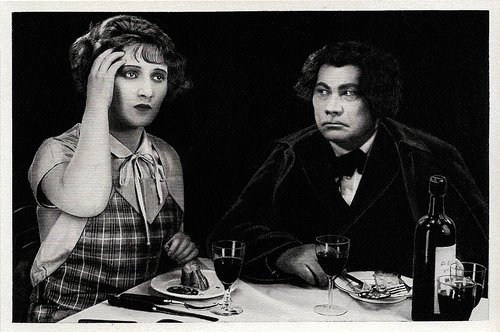
Anita Dorris and Paul Wegener in Svengali (1927). German collectors card by Ross Verlag in the series Vom Werden deutscher Filmkunst - Der Stumme Film, picture no. 135, group 43. Photo: Terra Film. Publicity still for Svengali (Gennaro Righelli, 1927).
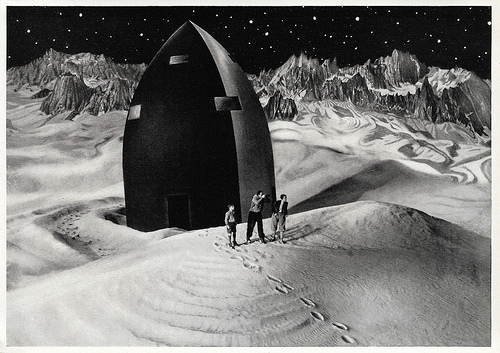
Willy Fritsch , Gerda Maurus and Gustl Stark-Gstettenbauer in Frau im Mond (1929). German collectors card by Ross Verlag in the series Vom Werden Deutscher Filmkunst - Der Stumme Film, picture no. 138, group 40. Photo: Ufa. Publicity still for Frau im Mond/Woman in the Moon (Fritz Lang, 1929).
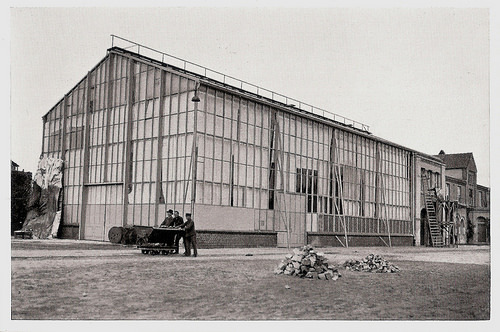
The Old Glass House of the Eiko Film Studio. German collectors card by Ross Verlag in the series Vom Werden deutscher Filmkunst - Der Stumme Film, picture no. 139, group 43. Photo: Eiko.
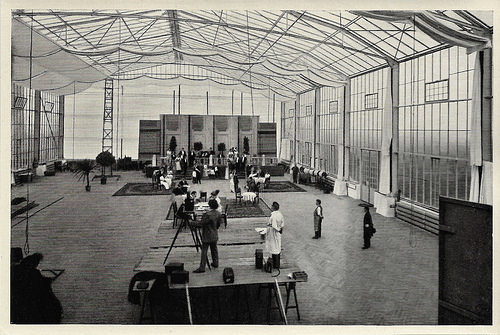
Small set for a society drama in the old glass house of the Eiko Film studio. German collectors card by Ross Verlag in the series Vom Werden deutscher Filmkunst - Der Stumme Film, no. 140. Photo: Ufa.
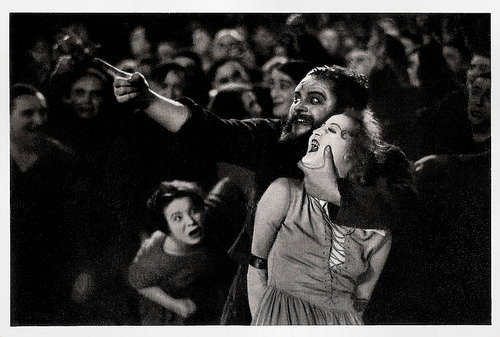
Heinrich George and Brigitte Helm in Metropolis (1926). German collectors card by Ross Verlag in the series Vom Werden deutscher Filmkunst - Der Stumme Film, picture, picture no. 143, group 43. Photo: Ufa. Caption: " Heinrich George plays the scene".
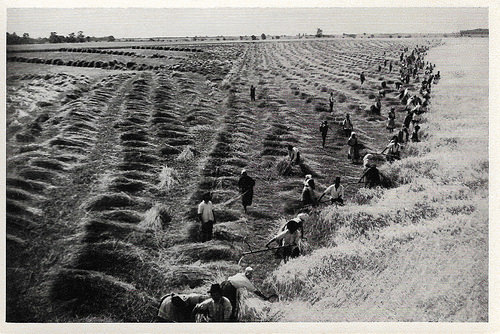
Ungarische Rhapsodie (1928). German collectors card by Ross Verlag in the series Vom Werden deutscher Filmkunst - Der Stumme Film, picture no. 146, group 43. Photo: Ufa. Publicity still for Ungarische Rhapsodie/Hungarian Rhapsody (Hanns Schwarz, 1928). Caption: "Harvest on a giant estate in Hungary as a backdrop for the film Hungarian Rhapsody".
For the film Anna Boleyn a tournament set is built at the Tempelhof studio. German collectors card by Ross Verlag in the series Vom Werden deutscher Filmkunst - Der Stumme Film, no. 149. Photo: Union-Messter-Film. Set for Anna Boleyn (Ernst Lubitsch, 1920).
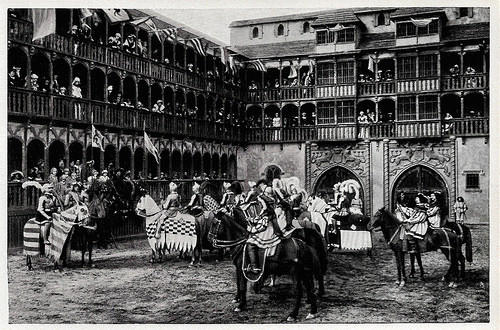
And as it later appeared in the film. German collectors card by Ross Verlag in the series Vom Werden deutscher Filmkunst - Der Stumme Film, picture no. 150, group 43. Photo: Ufa. Set for Anna Boleyn (Ernst Lubitsch, 1920).
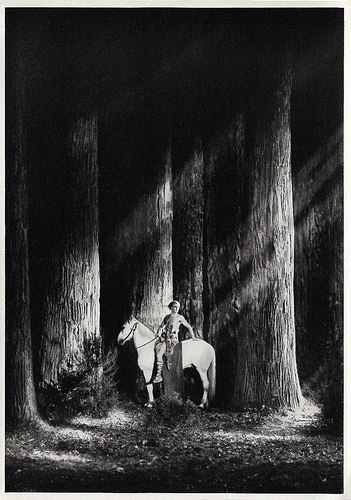
Paul Richter in Die Nibelungen: Siegfried (1924). German collectors card by Ross Verlag in the series Vom Werden deutscher Filmkunst - Der Stumme Film, picture no. 151, group 40. Photo: Ufa. Publicity still for Die Nibelungen: Siegfried (Fritz Lang, 1924). Caption: The artistic studio forest in the film Nibelungen. Paul Richter as Siegfried.
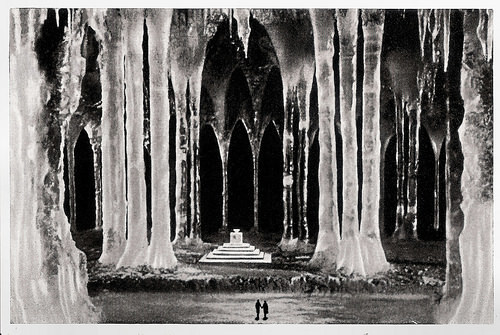
Model Der heilige Berg (1926). German collectors card by Ross Verlag in the series Vom Werden deutscher Filmkunst - Der Stumme Film, picture no. 153, group 43. Photo: Ufa. Model for the film Der heilige Berg/The Holy Mountain (Arnold Fanck, 1926).
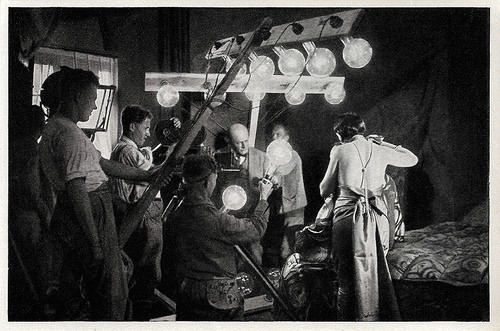
Ufa Studio Set. German collectors card by Ross Verlag in the series Vom Werden deutscher Filmkunst - Der Stumme Film, picture no, 158, group 43. Photo: Ufa. Caption: "Lighting of a small studio scene."
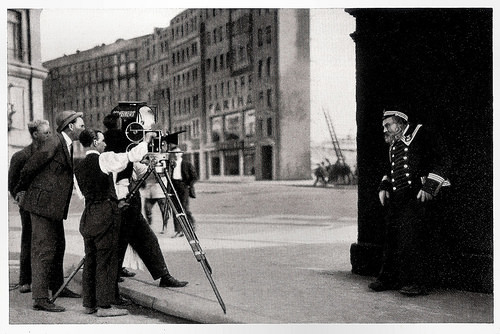
Emil Jannings during the shooting of Der letzte Mann (1924). German collectors card by Ross Verlag in the series Vom Werden deutscher Filmkunst - Der Stumme Film, picture no. 160, group 43. Photo: Ufa. Publicity still for Der letzte Mann/The Last Laugh (Friedrich Wilhelm Murnau, 1924). Caption: The Last Laugh is filmed, with a fixed camera.
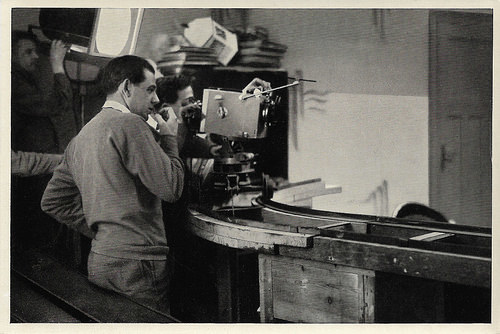
The unchained camera on rails. German collectors card by Ross Verlag in the series Vom Werden deutscher Filmkunst - Der Stumme Film, no. 161. Photo: Ufa.
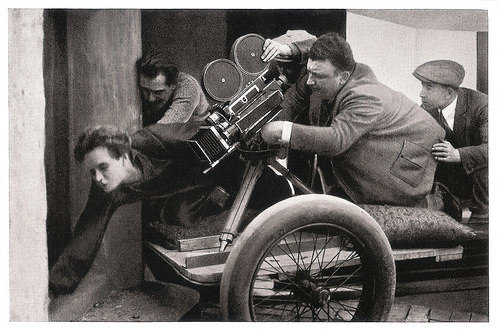
The unchained camera on the chassis. German collectors card by Ross Verlag in the series Vom Werden deutscher Filmkunst - Der Stumme Film, picture no. 162, group 43. Photo: Ufa.
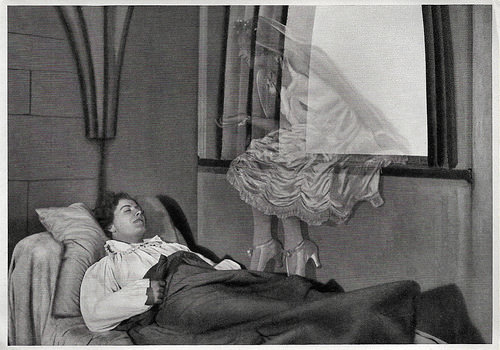
Hermann Thimig and Ossi Oswalda in Die Puppe (1919). German collectors card by Ross Verlag in the series Vom Werden deutscher Filmkunst - Der Stumme Film, no. 164, Group 40. Photo: Ufa. Publicity still for Die Puppe/The Doll (Ernst Lubitsch, 1919). Caption: From the film Die Puppe. Trick shot. Ossi Oswalda appears in Hermann Thimig 's dream.
See also Vom Werden deutscher Filmkunst, Part 1, Part 2, Part 3, and Part 4.
To be continued next Saturday!

Luciano Albertini in Der Mann auf dem Kometen (1925). German collectors card by Ross Verlag in the series Vom Werden deutscher Filmkunst - Der Stumme Film, no. 129. Photo: Phoebus-Film. Publicity still for Der Mann auf dem Kometen/The Man on the Comet (Alfred Halm, 1925).

Leni Riefenstahl in Die weiße Hölle vom Piz Palü (1929). German collectors card by Ross Verlag in the series Vom Werden deutscher Filmkunst - Der Stumme Film, picture no. 130, group 40. Photo: Ufa. Publicity still for Die weiße Hölle vom Piz Palü//The White Hell of Piz Palü (Arnold Fanck, G. W. Pabst, 1929).

Wege zu Kraft und Schönheit (1925). German collectors card by Ross Verlag in the series Vom Werden deutscher Filmkunst - Der Stumme Film, picture no, 131, group 43. Photo: Ufa. Publicity still for Wege zu Kraft und Schönheit/Ways to Strength and Beauty (Nicholas Kaufmann, Wilhelm Prager, 1925). Capture: Morgen (Morning).

Max Schreck in Nosferatu (1922). German collectors card by Ross Verlag in the series Vom Werden deutscher Filmkunst - Der Stumme Film, no. 134. Photo: Ufa. Publicity still for the first German horror film, Nosferatu (Friedrich Wilhelm Murnau, 1922).

Paul Wegener and Lyda Salmonova in Der verlorene Schatten (1921). German collectors card by Ross Verlag in the series Vom Werden deutscher Filmkunst - Der Stumme Film, no. 134. Photo: Ufa. Publicity still for Der verlorene Schatten/The Lost Shadow (Rochus Gliese, 1921).

Anita Dorris and Paul Wegener in Svengali (1927). German collectors card by Ross Verlag in the series Vom Werden deutscher Filmkunst - Der Stumme Film, picture no. 135, group 43. Photo: Terra Film. Publicity still for Svengali (Gennaro Righelli, 1927).

Willy Fritsch , Gerda Maurus and Gustl Stark-Gstettenbauer in Frau im Mond (1929). German collectors card by Ross Verlag in the series Vom Werden Deutscher Filmkunst - Der Stumme Film, picture no. 138, group 40. Photo: Ufa. Publicity still for Frau im Mond/Woman in the Moon (Fritz Lang, 1929).

The Old Glass House of the Eiko Film Studio. German collectors card by Ross Verlag in the series Vom Werden deutscher Filmkunst - Der Stumme Film, picture no. 139, group 43. Photo: Eiko.

Small set for a society drama in the old glass house of the Eiko Film studio. German collectors card by Ross Verlag in the series Vom Werden deutscher Filmkunst - Der Stumme Film, no. 140. Photo: Ufa.

Heinrich George and Brigitte Helm in Metropolis (1926). German collectors card by Ross Verlag in the series Vom Werden deutscher Filmkunst - Der Stumme Film, picture, picture no. 143, group 43. Photo: Ufa. Caption: " Heinrich George plays the scene".

Ungarische Rhapsodie (1928). German collectors card by Ross Verlag in the series Vom Werden deutscher Filmkunst - Der Stumme Film, picture no. 146, group 43. Photo: Ufa. Publicity still for Ungarische Rhapsodie/Hungarian Rhapsody (Hanns Schwarz, 1928). Caption: "Harvest on a giant estate in Hungary as a backdrop for the film Hungarian Rhapsody".
For the film Anna Boleyn a tournament set is built at the Tempelhof studio. German collectors card by Ross Verlag in the series Vom Werden deutscher Filmkunst - Der Stumme Film, no. 149. Photo: Union-Messter-Film. Set for Anna Boleyn (Ernst Lubitsch, 1920).

And as it later appeared in the film. German collectors card by Ross Verlag in the series Vom Werden deutscher Filmkunst - Der Stumme Film, picture no. 150, group 43. Photo: Ufa. Set for Anna Boleyn (Ernst Lubitsch, 1920).

Paul Richter in Die Nibelungen: Siegfried (1924). German collectors card by Ross Verlag in the series Vom Werden deutscher Filmkunst - Der Stumme Film, picture no. 151, group 40. Photo: Ufa. Publicity still for Die Nibelungen: Siegfried (Fritz Lang, 1924). Caption: The artistic studio forest in the film Nibelungen. Paul Richter as Siegfried.

Model Der heilige Berg (1926). German collectors card by Ross Verlag in the series Vom Werden deutscher Filmkunst - Der Stumme Film, picture no. 153, group 43. Photo: Ufa. Model for the film Der heilige Berg/The Holy Mountain (Arnold Fanck, 1926).

Ufa Studio Set. German collectors card by Ross Verlag in the series Vom Werden deutscher Filmkunst - Der Stumme Film, picture no, 158, group 43. Photo: Ufa. Caption: "Lighting of a small studio scene."

Emil Jannings during the shooting of Der letzte Mann (1924). German collectors card by Ross Verlag in the series Vom Werden deutscher Filmkunst - Der Stumme Film, picture no. 160, group 43. Photo: Ufa. Publicity still for Der letzte Mann/The Last Laugh (Friedrich Wilhelm Murnau, 1924). Caption: The Last Laugh is filmed, with a fixed camera.

The unchained camera on rails. German collectors card by Ross Verlag in the series Vom Werden deutscher Filmkunst - Der Stumme Film, no. 161. Photo: Ufa.

The unchained camera on the chassis. German collectors card by Ross Verlag in the series Vom Werden deutscher Filmkunst - Der Stumme Film, picture no. 162, group 43. Photo: Ufa.

Hermann Thimig and Ossi Oswalda in Die Puppe (1919). German collectors card by Ross Verlag in the series Vom Werden deutscher Filmkunst - Der Stumme Film, no. 164, Group 40. Photo: Ufa. Publicity still for Die Puppe/The Doll (Ernst Lubitsch, 1919). Caption: From the film Die Puppe. Trick shot. Ossi Oswalda appears in Hermann Thimig 's dream.
See also Vom Werden deutscher Filmkunst, Part 1, Part 2, Part 3, and Part 4.
To be continued next Saturday!
Published on September 01, 2017 22:00
August 31, 2017
Elton John
Sir Elton Hercules John CBE (1947) is an English singer-songwriter, composer, pianist, record producer, and occasional actor (Tommy!). He has worked with lyricist Bernie Taupin as his songwriter partner since 1967; they have collaborated on more than 30 albums. In his five-decade career Elton John had more than fifty Top 40 hits and has sold more than 250 million albums, making him one of the best-selling music artists in the world.
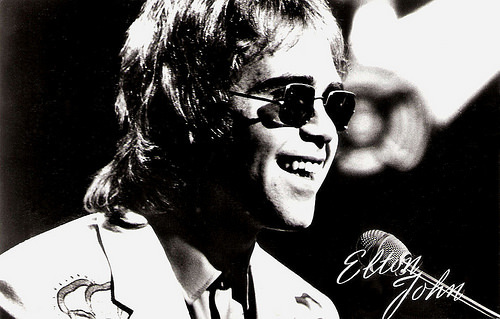
Dutch postcard by Muziek Parade, Bussum, no. AX 7212.
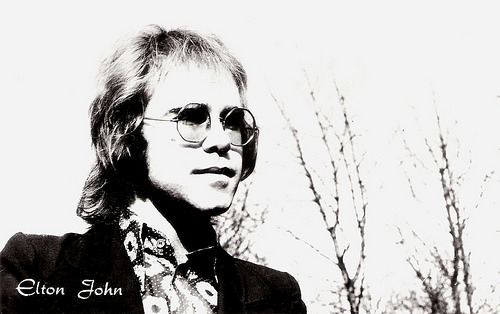
Dutch postcard by Muziek Parade, Bussum, no. AX 7297.
Gospel-chorded rockers and poignant ballads
Elton John was born Reginald Kenneth Dwight in the Pinner area of London, in 1947. He was the eldest child of Stanley Dwight, a flight lieutenant in the Royal Air Force, and the only child of Sheila Eileen (née Harris). He was raised in a council house by his maternal grandparents, in Pinner. His parents did not marry until he was 6 years old, when the family moved to a nearby semi-detached house.
Both of Dwight's parents were musically inclined, his father having been a trumpet player with the Bob Millar Band, a semi-professional big band that played at military dances. Elton learned to play piano at the age of 4. Only 11, he won a junior scholarship to the Royal Academy of Music and for the next five years, he attended Saturday classes at the Academy in central London.
By 1962 he and his friends formed a band called Bluesology. By day, the 15 years-old ran errands for a music publishing company. His nights, he divided between solo gigs at a London hotel bar and working with Bluesology.
His father tried to steer him toward a more conventional career, such as banking. At age 17, he left Pinner County Grammar School just prior to his A Level examinations to pursue a career in the music industry. His parents divorced and his mother married Fred Farebrother, whom Elton affectionately dubbed "Derf".
In 1966, the band became musician Long John Baldry's supporting band, and played 16 times at the legendary Marquee Club. Dwight met his songwriting partner, Bernie Taupin, in 1967, after they had both answered an advert by the A&R manager for Liberty Records for songwriters. Six months later Dwight was going by the name Elton John (merging the names of two members of Bluesology: saxophonist Elton Dean and Long John Baldry). For two years they wrote songs for other artists, including Lulu, and John also worked as a session musician for artists such as the Hollies and the Scaffold.
In 1969 his debut album, Empty Sky, was released. The formula for this and subsequent albums was gospel-chorded rockers and poignant ballads. In 1970 the single Your Song from his second album Elton John reached the top ten in the UK and the US. It was his first hit single. The album soon became his first hit album, reaching number four on the US Billboard 200 and number five on the UK Albums Chart. John and Taupin then wrote the soundtrack to the film Friends and then the album Madman Across the Water.
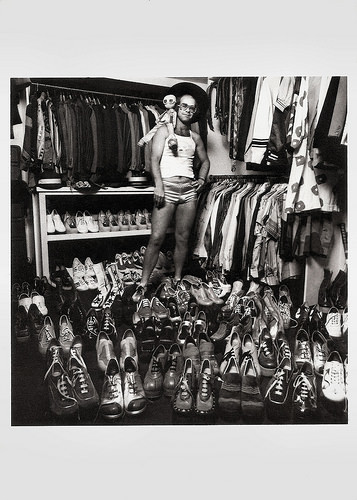
American card by Fotofolio, NY, NY, no. P 287. Photo: Terry O'Neill, 1975.
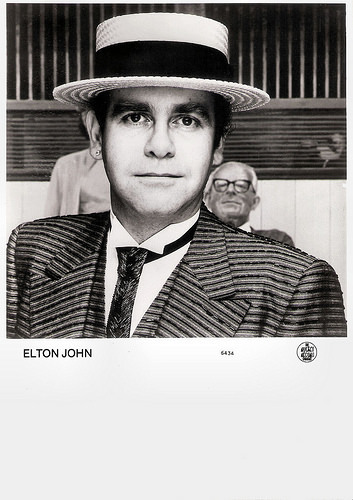
British card by Rocket Record, no. 6434.

British card by Rocket Record.
Glam Rock Star
1970–1976 is Elton John's most commercially successful period, but is also held in the most regard critically. In 1972, he released Honky Château with the hit singles Rocket Man and Honky Cat. It became John's first US number one album, spending five weeks at the top of the Billboard 200.
It began a streak of seven consecutive US number one albums. The pop album Don't Shoot Me I'm Only the Piano Player came out at the start of 1973 and reached number one in the UK, the US, Australia among others. The album produced the hits Crocodile Rock, his first US Billboard Hot 100 number one, and Daniel.
Goodbye Yellow Brick Road, released in October 1973, gained instant critical acclaim and topped the chart on both sides of the Atlantic, remaining at number one for two months. It temporarily established John as a glam rock star. It contained the hits Bennie and the Jets, Goodbye Yellow Brick Road and Candle in the Wind.
In 1974, a collaboration with John Lennon took place, resulting in Lennon's appearance on Elton John's single cover of the Beatles ' Lucy in the Sky with Diamonds. Lennon is credited as Dr. Winston O'Boogie. The song was used for the film All This and World War II (Susan Winslow, 1976). John also released the album Caribou (1974), which featured The Bitch Is Back and the orchestrated Don't Let the Sun Go Down on Me.
Pete Townshend of the Who asked John to play a character called the 'Local Lad' in the film of the rock opera Tommy (Ken Russell, 1975). In the film, he is shown performing the song Pinball Wizard while playing a pinball machine integrated with a miniature piano keyboard.
The 1975 autobiographical album Captain Fantastic and the Brown Dirt Cowboy debuted at number one in the US, the first album ever to do so, and stayed at the top for seven weeks. John revealed his previously ambiguous personality on the album, with Bernie Taupin's lyrics describing their early days as struggling songwriters and musicians in London. Someone Saved My Life Tonight was the hit single from this album. His next album, the rock-oriented Rock of the Westies, again entered the US albums chart at number 1.
In 1976, the live album Here and There was released. A few months later it was followed by the Blue Moves album, which contained the single Sorry Seems to Be the Hardest Word. His biggest success that year was Don't Go Breaking My Heart, a duet with Kiki Dee that topped both the UK and US charts. In November 1977, Elton John announced he was retiring from performing.
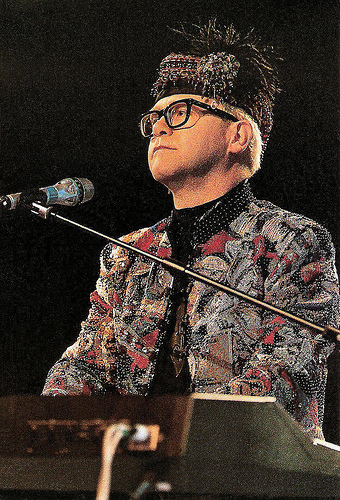
French postcard, no. A026.
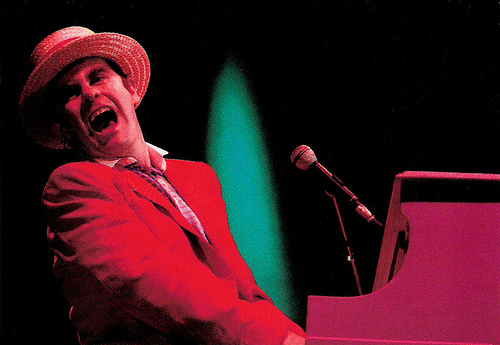
French postcard by Humour à la Carte, Paris, no. 3260.
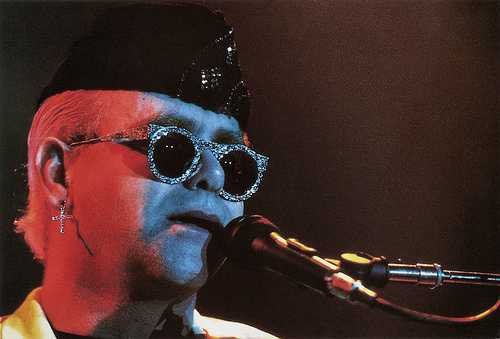
French postcard, no. A105.
Lasting impact on British culture
Elton John kept recording and had several other hits throughout the 1980s, including Nikita which featured in a music video directed by Ken Russell. Along with Tim Rice, Elton John wrote the songs for Disney's animated film The Lion King (Roger Allers, Rob Minkoff, 1994). Both John's songs Can You Feel the Love Tonight and Circle of Life became hits.
John also achieved success in musical theatre, both in the West End and on Broadway, composing the music for the stage version of The Lion King (1997), Aida (1999) and Billy Elliot the Musical (2005). In 2000, he and Tim Rice teamed again to create songs for the animated film The Road to El Dorado (Bibo Bergeron, Don Paul, 2000).
On 6 September 1997, he performed a new version of Candle in the Wind, in tribute to Princess Diana at her funeral, with new lyrics specially written by Bernie Taupin. The song became the fastest and biggest-selling single of all time, eventually selling over 33 million copies worldwide.
Elton John was inducted into the Rock and Roll Hall of Fame in 1994, is an inductee into the Songwriters Hall of Fame, and is a fellow of the British Academy of Songwriters, Composers and Authors. Having been named a Order of the British Empire in 1996, John was made a Knight Bachelor by Elizabeth II for "services to music and charitable services" in 1998. John received five Grammy Awards, five Brit Awards – winning two awards for Outstanding Contribution to Music and the first Brits Icon in 2013 for his "lasting impact on British culture", an Academy Award, a Golden Globe Award, a Tony Award, a Disney Legends award, and the Kennedy Center Honors in 2004.
Elton John announced he was bisexual in 1976 and he has been openly gay since 1988. In 2005 he entered into a civil partnership with filmmaker David Furnish, the first day that civil unions between homosexuals were legal in England and Wales. After same-sex marriage became legal in England and Wales in 2014, he wed Furnish on 21 December 2014. His husband made the documentary Elton John: Tantrums & Tiaras (1997). Elton John and David Furnish have two sons, both born via surrogate: Zachary Jackson Levon Furnish-John (2010) and Elijah Joseph Daniel John (2013). The godmother of his sons is Lady Gaga.
Elton John is a champion for LGBT social movements worldwide. He has been heavily involved in the fight against AIDS since the late 1980s. In 1992, he decided that all profits from his singles would be donated to AIDS charities and formed the Elton John AIDS Foundation. The foundation has become one of the world's largest nonprofit AIDS organisations. In 1993 it began hosting the annual Academy Award Party, which has since become one of the highest-profile Oscar parties in the Hollywood film industry. Since its inception, the foundation has raised over US $200 million.
In 2006, Elton John was estimated to have sold 250 million albums during his career. From 1970 till 2009, he has had at least one charted Billboard hit every year.
Trailer for Friends (Lewis Gilbert, 1971). Title song: Elton John. Source: Paulo Moreira (YouTube).
Elton John performs Pinball Wizard in Tommy (Ken Russell, 1975). Source: Umbrella Entertainment (YouTube).
Elton John and Kiki Dee sing Don't Go Breaking My Heart. Source: EltonJohnVEVO (YouTube).
Sources: Wikipedia and .

Dutch postcard by Muziek Parade, Bussum, no. AX 7212.

Dutch postcard by Muziek Parade, Bussum, no. AX 7297.
Gospel-chorded rockers and poignant ballads
Elton John was born Reginald Kenneth Dwight in the Pinner area of London, in 1947. He was the eldest child of Stanley Dwight, a flight lieutenant in the Royal Air Force, and the only child of Sheila Eileen (née Harris). He was raised in a council house by his maternal grandparents, in Pinner. His parents did not marry until he was 6 years old, when the family moved to a nearby semi-detached house.
Both of Dwight's parents were musically inclined, his father having been a trumpet player with the Bob Millar Band, a semi-professional big band that played at military dances. Elton learned to play piano at the age of 4. Only 11, he won a junior scholarship to the Royal Academy of Music and for the next five years, he attended Saturday classes at the Academy in central London.
By 1962 he and his friends formed a band called Bluesology. By day, the 15 years-old ran errands for a music publishing company. His nights, he divided between solo gigs at a London hotel bar and working with Bluesology.
His father tried to steer him toward a more conventional career, such as banking. At age 17, he left Pinner County Grammar School just prior to his A Level examinations to pursue a career in the music industry. His parents divorced and his mother married Fred Farebrother, whom Elton affectionately dubbed "Derf".
In 1966, the band became musician Long John Baldry's supporting band, and played 16 times at the legendary Marquee Club. Dwight met his songwriting partner, Bernie Taupin, in 1967, after they had both answered an advert by the A&R manager for Liberty Records for songwriters. Six months later Dwight was going by the name Elton John (merging the names of two members of Bluesology: saxophonist Elton Dean and Long John Baldry). For two years they wrote songs for other artists, including Lulu, and John also worked as a session musician for artists such as the Hollies and the Scaffold.
In 1969 his debut album, Empty Sky, was released. The formula for this and subsequent albums was gospel-chorded rockers and poignant ballads. In 1970 the single Your Song from his second album Elton John reached the top ten in the UK and the US. It was his first hit single. The album soon became his first hit album, reaching number four on the US Billboard 200 and number five on the UK Albums Chart. John and Taupin then wrote the soundtrack to the film Friends and then the album Madman Across the Water.

American card by Fotofolio, NY, NY, no. P 287. Photo: Terry O'Neill, 1975.

British card by Rocket Record, no. 6434.

British card by Rocket Record.
Glam Rock Star
1970–1976 is Elton John's most commercially successful period, but is also held in the most regard critically. In 1972, he released Honky Château with the hit singles Rocket Man and Honky Cat. It became John's first US number one album, spending five weeks at the top of the Billboard 200.
It began a streak of seven consecutive US number one albums. The pop album Don't Shoot Me I'm Only the Piano Player came out at the start of 1973 and reached number one in the UK, the US, Australia among others. The album produced the hits Crocodile Rock, his first US Billboard Hot 100 number one, and Daniel.
Goodbye Yellow Brick Road, released in October 1973, gained instant critical acclaim and topped the chart on both sides of the Atlantic, remaining at number one for two months. It temporarily established John as a glam rock star. It contained the hits Bennie and the Jets, Goodbye Yellow Brick Road and Candle in the Wind.
In 1974, a collaboration with John Lennon took place, resulting in Lennon's appearance on Elton John's single cover of the Beatles ' Lucy in the Sky with Diamonds. Lennon is credited as Dr. Winston O'Boogie. The song was used for the film All This and World War II (Susan Winslow, 1976). John also released the album Caribou (1974), which featured The Bitch Is Back and the orchestrated Don't Let the Sun Go Down on Me.
Pete Townshend of the Who asked John to play a character called the 'Local Lad' in the film of the rock opera Tommy (Ken Russell, 1975). In the film, he is shown performing the song Pinball Wizard while playing a pinball machine integrated with a miniature piano keyboard.
The 1975 autobiographical album Captain Fantastic and the Brown Dirt Cowboy debuted at number one in the US, the first album ever to do so, and stayed at the top for seven weeks. John revealed his previously ambiguous personality on the album, with Bernie Taupin's lyrics describing their early days as struggling songwriters and musicians in London. Someone Saved My Life Tonight was the hit single from this album. His next album, the rock-oriented Rock of the Westies, again entered the US albums chart at number 1.
In 1976, the live album Here and There was released. A few months later it was followed by the Blue Moves album, which contained the single Sorry Seems to Be the Hardest Word. His biggest success that year was Don't Go Breaking My Heart, a duet with Kiki Dee that topped both the UK and US charts. In November 1977, Elton John announced he was retiring from performing.

French postcard, no. A026.

French postcard by Humour à la Carte, Paris, no. 3260.

French postcard, no. A105.
Lasting impact on British culture
Elton John kept recording and had several other hits throughout the 1980s, including Nikita which featured in a music video directed by Ken Russell. Along with Tim Rice, Elton John wrote the songs for Disney's animated film The Lion King (Roger Allers, Rob Minkoff, 1994). Both John's songs Can You Feel the Love Tonight and Circle of Life became hits.
John also achieved success in musical theatre, both in the West End and on Broadway, composing the music for the stage version of The Lion King (1997), Aida (1999) and Billy Elliot the Musical (2005). In 2000, he and Tim Rice teamed again to create songs for the animated film The Road to El Dorado (Bibo Bergeron, Don Paul, 2000).
On 6 September 1997, he performed a new version of Candle in the Wind, in tribute to Princess Diana at her funeral, with new lyrics specially written by Bernie Taupin. The song became the fastest and biggest-selling single of all time, eventually selling over 33 million copies worldwide.
Elton John was inducted into the Rock and Roll Hall of Fame in 1994, is an inductee into the Songwriters Hall of Fame, and is a fellow of the British Academy of Songwriters, Composers and Authors. Having been named a Order of the British Empire in 1996, John was made a Knight Bachelor by Elizabeth II for "services to music and charitable services" in 1998. John received five Grammy Awards, five Brit Awards – winning two awards for Outstanding Contribution to Music and the first Brits Icon in 2013 for his "lasting impact on British culture", an Academy Award, a Golden Globe Award, a Tony Award, a Disney Legends award, and the Kennedy Center Honors in 2004.
Elton John announced he was bisexual in 1976 and he has been openly gay since 1988. In 2005 he entered into a civil partnership with filmmaker David Furnish, the first day that civil unions between homosexuals were legal in England and Wales. After same-sex marriage became legal in England and Wales in 2014, he wed Furnish on 21 December 2014. His husband made the documentary Elton John: Tantrums & Tiaras (1997). Elton John and David Furnish have two sons, both born via surrogate: Zachary Jackson Levon Furnish-John (2010) and Elijah Joseph Daniel John (2013). The godmother of his sons is Lady Gaga.
Elton John is a champion for LGBT social movements worldwide. He has been heavily involved in the fight against AIDS since the late 1980s. In 1992, he decided that all profits from his singles would be donated to AIDS charities and formed the Elton John AIDS Foundation. The foundation has become one of the world's largest nonprofit AIDS organisations. In 1993 it began hosting the annual Academy Award Party, which has since become one of the highest-profile Oscar parties in the Hollywood film industry. Since its inception, the foundation has raised over US $200 million.
In 2006, Elton John was estimated to have sold 250 million albums during his career. From 1970 till 2009, he has had at least one charted Billboard hit every year.
Trailer for Friends (Lewis Gilbert, 1971). Title song: Elton John. Source: Paulo Moreira (YouTube).
Elton John performs Pinball Wizard in Tommy (Ken Russell, 1975). Source: Umbrella Entertainment (YouTube).
Elton John and Kiki Dee sing Don't Go Breaking My Heart. Source: EltonJohnVEVO (YouTube).
Sources: Wikipedia and .
Published on August 31, 2017 22:00
August 30, 2017
Il tamburino sardo (1915)
On the last two Thursdays, we did posts on Naufragio/Shipwreck (Umberto Paradisi, 1915) and Il piccolo scrivano fiorentino/The little scribe from Florence (Leopoldo Carlucci, 1915). Both belonged to a series of films based on the stories in Cuore (1886) by Edmondo De Amicis. The series was produced by Gloria, the film company in Turin that also produced the first films of diva Lyda Borelli. Child star Ermanno Roveri acted in many of these films, but in Il tamburino sardo/The Little Drummer Boy (Vittorio Rossi Pianelli, 1915) the boy of the title is played by Vittorio Petrungaro.
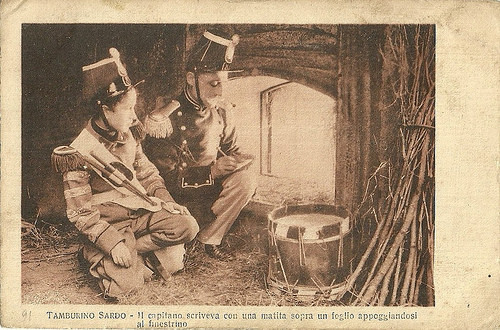
Italian postcard for the film Il tamburino sardo (Vittorio Rossi Pianelli, 1915), with Vittorio Petrungaro as the boy and Telemaco Ruggeri as the captain. Caption: The captain wrote with a pencil on a paper, leaning onto the little window.
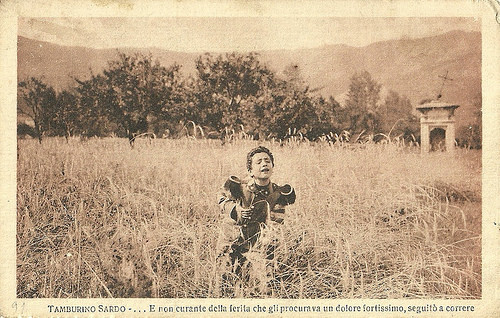
Italian postcard for the film Il tamburino sardo (Vittorio Rossi Pianelli, 1915). Caption: Not taking care of his wound that caused him a very strong pain, he continued to run.
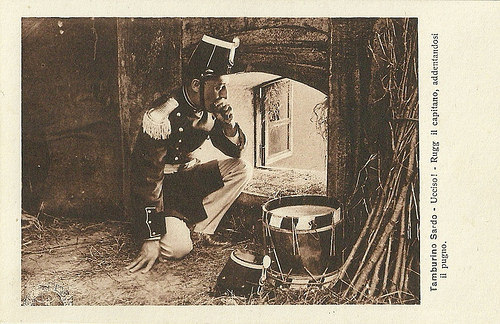
Italian postcard for the film Il tamburino sardo (Vittorio Rossi Pianelli, 1915). Caption: Killed! the captain whispered, biting his fist.
The Little Drummer Boy
Il tamburino sardo/The Little Drummer Boy (Vittorio Rossi Pianelli, 1915) is based on the 1889 story of the same name of the series Cuore (Heart) by Edmondo De Amicis.
During the Italian Risorgimento, in the countryside of Verona, a Sardinian boy meets Italian soldiers and becomes their mascot (the little drummer boy). It happens just before a big battle with the Austrian army.
During the battle, the Italian soldiers are surrounded by the Austrian enemy, and trapped in an abandoned house. The captain sends the drummer boy, small and agile, across the enemy lines to get help.
The boy succeeds with great difficulty, despite being shot by the enemy. Afterwards the captain visits a hospital and notices the boy's leg is amputated.
A doctor tells his leg could have been saved if he hadn't run like madman. The captain realises that the boy has been a hero. Vittorio Petrungaro plays the boy and Telemaco Ruggeri the captain.
In 2011 the Milanese cinematheque Cineteca Italiana restored a tinted print of Il tamburino sardo (1915).
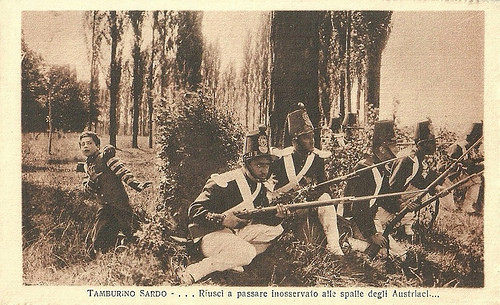
Italian postcard for the film Il tamburino sardo (Vittorio Rossi Pianelli, 1915). Captain: He managed to pass unobserved behind the Austrians.
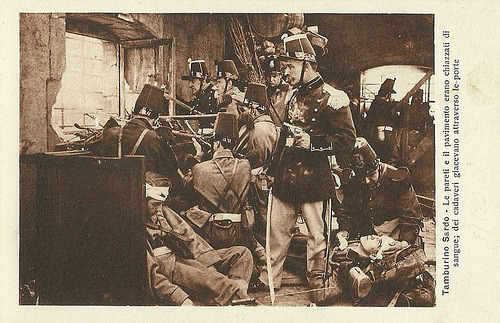
Italian postcard for the film Il tamburino sardo (Vittorio Rossi Pianelli, 1915). Caption: The walls and the floor were splattered with blood, corpses lay through the doors.
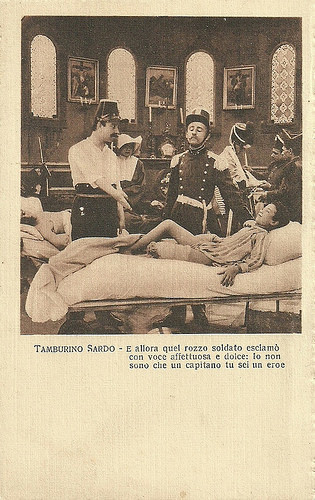
Italian postcard for the film Il tamburino sardo (Vittorio Rossi Pianelli, 1915). Captain: It was then that this rude soldier exclaimed with sweet and affectionate voice: I am just a captain, but you are a hero.
Sources: European Film Gateway and IMDb.

Italian postcard for the film Il tamburino sardo (Vittorio Rossi Pianelli, 1915), with Vittorio Petrungaro as the boy and Telemaco Ruggeri as the captain. Caption: The captain wrote with a pencil on a paper, leaning onto the little window.

Italian postcard for the film Il tamburino sardo (Vittorio Rossi Pianelli, 1915). Caption: Not taking care of his wound that caused him a very strong pain, he continued to run.

Italian postcard for the film Il tamburino sardo (Vittorio Rossi Pianelli, 1915). Caption: Killed! the captain whispered, biting his fist.
The Little Drummer Boy
Il tamburino sardo/The Little Drummer Boy (Vittorio Rossi Pianelli, 1915) is based on the 1889 story of the same name of the series Cuore (Heart) by Edmondo De Amicis.
During the Italian Risorgimento, in the countryside of Verona, a Sardinian boy meets Italian soldiers and becomes their mascot (the little drummer boy). It happens just before a big battle with the Austrian army.
During the battle, the Italian soldiers are surrounded by the Austrian enemy, and trapped in an abandoned house. The captain sends the drummer boy, small and agile, across the enemy lines to get help.
The boy succeeds with great difficulty, despite being shot by the enemy. Afterwards the captain visits a hospital and notices the boy's leg is amputated.
A doctor tells his leg could have been saved if he hadn't run like madman. The captain realises that the boy has been a hero. Vittorio Petrungaro plays the boy and Telemaco Ruggeri the captain.
In 2011 the Milanese cinematheque Cineteca Italiana restored a tinted print of Il tamburino sardo (1915).

Italian postcard for the film Il tamburino sardo (Vittorio Rossi Pianelli, 1915). Captain: He managed to pass unobserved behind the Austrians.

Italian postcard for the film Il tamburino sardo (Vittorio Rossi Pianelli, 1915). Caption: The walls and the floor were splattered with blood, corpses lay through the doors.

Italian postcard for the film Il tamburino sardo (Vittorio Rossi Pianelli, 1915). Captain: It was then that this rude soldier exclaimed with sweet and affectionate voice: I am just a captain, but you are a hero.
Sources: European Film Gateway and IMDb.
Published on August 30, 2017 22:00
August 29, 2017
Mireille Darc (1938-2017)
Last Monday, 28 August 2017, French actress Mireille Darc passed away in Paris. She was Alain Delon's longtime costar and companion. She usually played comedic roles or the ‘cool blonde’ in thrillers, but she also appeared as the lead character in Jean-Luc Godard's disturbing classic Week End (1967). Darc was 79.
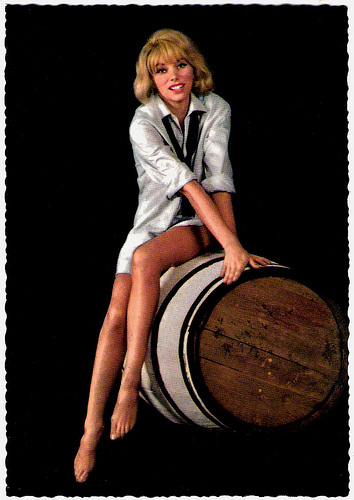
German postcard by Krüger, no. 902/331. Photo: Gérard Decaux.
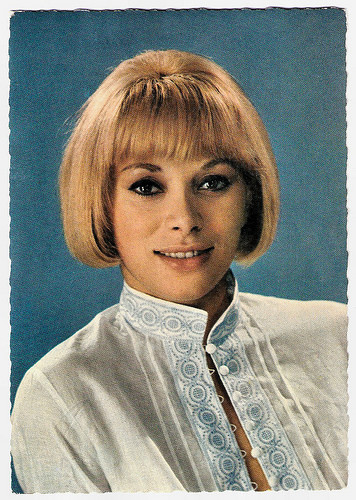
French postcard by E.D.U.G., no. 473. Photo: Sam Levin.
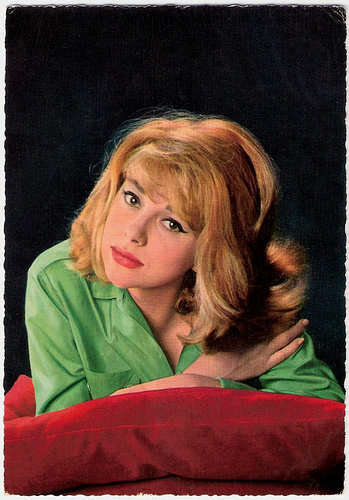
German postcard by Krüger, no. 902/197. Photo: Gérard Decaux.
Jean-Luc Godard
Mireille Darc was born Mireille Aigroz in Toulon, France in 1938. Her Swiss father was a gardener and her French mother worked in a grocery shop. At fourteen, she decided to go to the Conservatoire d'art dramatique de Toulon (Conservatory of Dramatic Arts in Toulon), and in 1959 she went to Paris, for she intended to become a member of the Comédie Française.
But the energetic and adventurous Darc worked first as a mannequin and a television performer. She was spotted for TV by director Claude Barma and debuted in his La Grande Brétèche/Great Bretèche (1960). Her first leading TV role came the following year with Hauteclaire (Jean Prat, 1961).
She decided to become a film actress, and she made her film debut in a small role alongside Jean-Paul Belmondo in the ‘policier’ Les Distractions/Trapped by Fear (Jacques Dupont, 1960).
In the comedy Pouic-Pouic (Jean Girault, 1963) she had a bigger part as Louis de Funès ’ daughter. Opposite Jean Gabin , she played his former-maid-turned-hooker in Monsieur (Jean-Paul Le Chanois, 1964) and she starred as a spy opposite Lino Ventura in the action comedy Les Barbouzes/The Great Spy Chase (Georges Lautner, 1964).
In 1964, she also made her stage debut opposite Philippe Noiret and Bernard Blier in the play Photo finish, written by Peter Ustinov. She also recorded a few EP’s.
Darc had her breakthrough with the psychological thriller Galia (Georges Lautner, 1965). Together with director George Lautner, she would make a total of thirteen films, including the terrific Film Noir parody Ne nous fâchons pas/Let's Not Get Angry (Georges Lautner, 1966).
Her most famous film of the 1960s is Jean-Luc Godard’s classic comedy-drama Week End (1967). It tells the story of a young couple (Darc and Jean Yanne), who set out to visit their parents in the countryside one week-end, and find themselves falling upon an incredible traffic jam and a subsequent nightmarish odyssey with car crashes, anarchy and cannibalism.
At Films de France , James Travers calls Week End “a deeply disturbing picture of a world that is in the process of disintegration as the forces of capitalism and socialist revolution lock horns and tear the established order apart. The film is best remembered for its ten minute long sequence in which the camera tracks slowly along a seemingly interminable traffic jam in a country lane, whose peace is ruined by the unending blare of irate klaxons - a chilling visual metaphor for where our society may be heading.”
It was through Mireille Darc’s insistence that she would make a film with Jean-Luc Godard that the director was able to secure the comparatively large budget for Week-End. Darc was under contract with a film production company and refused to make another film until she had appeared in a film directed by Godard. As a result, Week End is the best known and most commercially successful of Godard’s political films, and some regard it as one of the most important films of the 1960s.
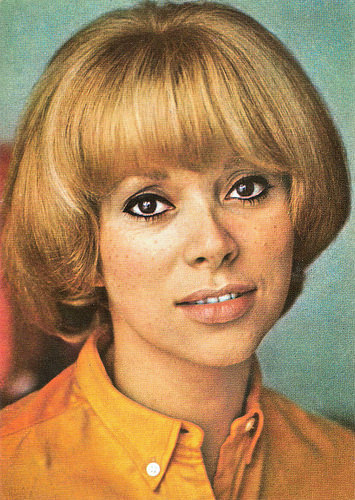
Romanian postcard by Filmului Acin.
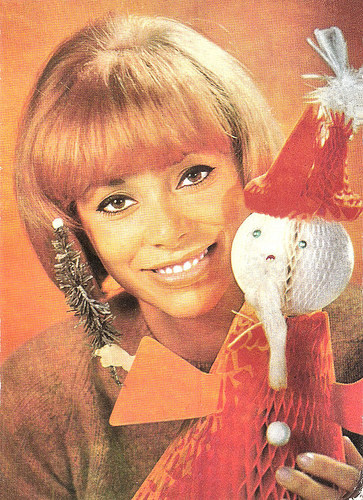
Romanian postcard by Casa Filmului Acin, no. 436.
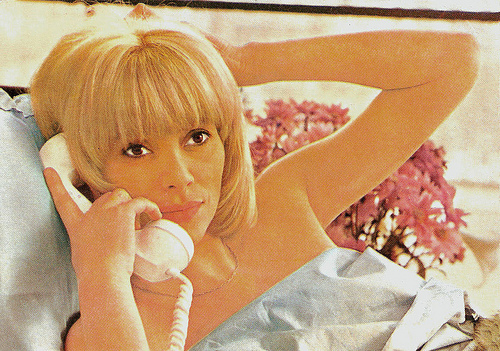
Romanian postcard by Casa Filmului Acin.
Alain Delon
In 1968, Mireille Darc met and fell in love with Alain Delon on the set of Jeff (Jean Herman, 1969). Their love affair would last for fifteen years. (However, some sources claim they separated in 1978).
After Jeff, they appeared together in several more films: Borsalino (Jacques Deray, 1970), Madly/The Love Mates (Roger Kahane, 1970), Il était une fois un flic/There Was Once a Cop (Georges Lautner, 1971), Les seins de glace/Icy Breasts (Georges Lautner, 1974), Borsalino and Co. (Jacques Deray, 1974), L'Homme pressé/The Hurried Man (Edouard Molinaro, 1977), Mort d'un pourri/Death of a Corrupt Man (Georges Lautner, 1977), Pour la peau d'un flic/For a Cop's Hide (Alain Delon, 1981) and the television series Frank Riva (2003-2004).
Mireille Darc was most successful with her roles in comedies like the international hit Le Grand Blond avec une chaussure noire/Tall Blond Man With One Black Shoe (Yves Robert, 1972) starring Pierre Richard . She also co-starred as Richard's girlfriend in the sequel, Le Retour du grand blond/The Return of the Tall Blond Man with One Black Shoe (Yves Robert, 1974). A sensation was her ultra-sexy dress in these amiable and enjoyable spy comedies.
In the early 1970s, Darc was very popular film star and sex symbol in France, but the following decade was a troublesome period for her. In 1980, she had an open-heart operation and the painful experience lead her to write a documentary film. She switched from acting to directing, choosing subjects such as organ transplants, prostitution, and prisons for women.
In 1983 she was seriously injured when the car in which she was riding collided with a truck. She sustained many injuries from the accident and her acting career was interrupted. She quit film acting, to focus on photography and her stage work. For television she directed the moderately successful TV film La Barbare/The Savage (Mireille Darc, 1989) with Murray Head.
During the 1990s, she appeared in several popular TV series including Les coeurs brûlés/Burnt Hearts (Jean Sagols, 1992-1994). In 2005 she published her memoirs, Tant que battra mon coeur/Until My Heart is Beating, and that same year, Jacques Chirac awarded her the Légion d'honneur.
For the first time, she appeared on stage opposite Alain Delon in Sur la route de Madison/The Bridges of Madison County (2007), directed by Anne Bourgeois. The play is an adaptation of the novel by Robert James Waller and the film by Clint Eastwood .
Mireille Darc has been married twice: first to journalist and writer Pierre Barret (1983-1988 - his death) and since 2002 to architect Pascal Desprez. She is the godmother of author Romain Sardou. Darc last screen appearance was in the TV film Le grand restaurant II (Gérard Pullicino, 2011) with Pierre Palmade.
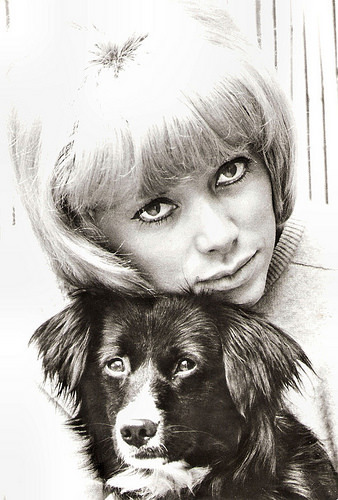
Romanian postcard by Casa Filmului Acin, no. 123.
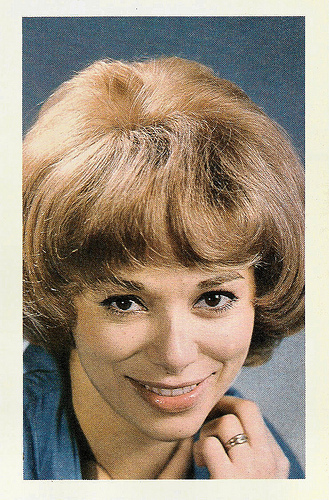
Vintage postcard.
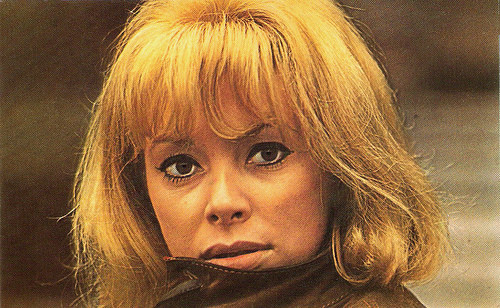
French postcard by Corvisart, Epinal.
Trailer for Pouic-Pouic (1963). Source: Joebodnar (YouTube).
Mireille Darc sings Helicopter, written by Serge Gainsbourg . Source: Johnxxx2000 (YouTube).
Sources: Mireille Darc (Tant que battra ma cœur - French), James Travers (Films de France), Sandra Brennan (AllMovie), Wikipedia (French), and .

German postcard by Krüger, no. 902/331. Photo: Gérard Decaux.

French postcard by E.D.U.G., no. 473. Photo: Sam Levin.

German postcard by Krüger, no. 902/197. Photo: Gérard Decaux.
Jean-Luc Godard
Mireille Darc was born Mireille Aigroz in Toulon, France in 1938. Her Swiss father was a gardener and her French mother worked in a grocery shop. At fourteen, she decided to go to the Conservatoire d'art dramatique de Toulon (Conservatory of Dramatic Arts in Toulon), and in 1959 she went to Paris, for she intended to become a member of the Comédie Française.
But the energetic and adventurous Darc worked first as a mannequin and a television performer. She was spotted for TV by director Claude Barma and debuted in his La Grande Brétèche/Great Bretèche (1960). Her first leading TV role came the following year with Hauteclaire (Jean Prat, 1961).
She decided to become a film actress, and she made her film debut in a small role alongside Jean-Paul Belmondo in the ‘policier’ Les Distractions/Trapped by Fear (Jacques Dupont, 1960).
In the comedy Pouic-Pouic (Jean Girault, 1963) she had a bigger part as Louis de Funès ’ daughter. Opposite Jean Gabin , she played his former-maid-turned-hooker in Monsieur (Jean-Paul Le Chanois, 1964) and she starred as a spy opposite Lino Ventura in the action comedy Les Barbouzes/The Great Spy Chase (Georges Lautner, 1964).
In 1964, she also made her stage debut opposite Philippe Noiret and Bernard Blier in the play Photo finish, written by Peter Ustinov. She also recorded a few EP’s.
Darc had her breakthrough with the psychological thriller Galia (Georges Lautner, 1965). Together with director George Lautner, she would make a total of thirteen films, including the terrific Film Noir parody Ne nous fâchons pas/Let's Not Get Angry (Georges Lautner, 1966).
Her most famous film of the 1960s is Jean-Luc Godard’s classic comedy-drama Week End (1967). It tells the story of a young couple (Darc and Jean Yanne), who set out to visit their parents in the countryside one week-end, and find themselves falling upon an incredible traffic jam and a subsequent nightmarish odyssey with car crashes, anarchy and cannibalism.
At Films de France , James Travers calls Week End “a deeply disturbing picture of a world that is in the process of disintegration as the forces of capitalism and socialist revolution lock horns and tear the established order apart. The film is best remembered for its ten minute long sequence in which the camera tracks slowly along a seemingly interminable traffic jam in a country lane, whose peace is ruined by the unending blare of irate klaxons - a chilling visual metaphor for where our society may be heading.”
It was through Mireille Darc’s insistence that she would make a film with Jean-Luc Godard that the director was able to secure the comparatively large budget for Week-End. Darc was under contract with a film production company and refused to make another film until she had appeared in a film directed by Godard. As a result, Week End is the best known and most commercially successful of Godard’s political films, and some regard it as one of the most important films of the 1960s.

Romanian postcard by Filmului Acin.

Romanian postcard by Casa Filmului Acin, no. 436.

Romanian postcard by Casa Filmului Acin.
Alain Delon
In 1968, Mireille Darc met and fell in love with Alain Delon on the set of Jeff (Jean Herman, 1969). Their love affair would last for fifteen years. (However, some sources claim they separated in 1978).
After Jeff, they appeared together in several more films: Borsalino (Jacques Deray, 1970), Madly/The Love Mates (Roger Kahane, 1970), Il était une fois un flic/There Was Once a Cop (Georges Lautner, 1971), Les seins de glace/Icy Breasts (Georges Lautner, 1974), Borsalino and Co. (Jacques Deray, 1974), L'Homme pressé/The Hurried Man (Edouard Molinaro, 1977), Mort d'un pourri/Death of a Corrupt Man (Georges Lautner, 1977), Pour la peau d'un flic/For a Cop's Hide (Alain Delon, 1981) and the television series Frank Riva (2003-2004).
Mireille Darc was most successful with her roles in comedies like the international hit Le Grand Blond avec une chaussure noire/Tall Blond Man With One Black Shoe (Yves Robert, 1972) starring Pierre Richard . She also co-starred as Richard's girlfriend in the sequel, Le Retour du grand blond/The Return of the Tall Blond Man with One Black Shoe (Yves Robert, 1974). A sensation was her ultra-sexy dress in these amiable and enjoyable spy comedies.
In the early 1970s, Darc was very popular film star and sex symbol in France, but the following decade was a troublesome period for her. In 1980, she had an open-heart operation and the painful experience lead her to write a documentary film. She switched from acting to directing, choosing subjects such as organ transplants, prostitution, and prisons for women.
In 1983 she was seriously injured when the car in which she was riding collided with a truck. She sustained many injuries from the accident and her acting career was interrupted. She quit film acting, to focus on photography and her stage work. For television she directed the moderately successful TV film La Barbare/The Savage (Mireille Darc, 1989) with Murray Head.
During the 1990s, she appeared in several popular TV series including Les coeurs brûlés/Burnt Hearts (Jean Sagols, 1992-1994). In 2005 she published her memoirs, Tant que battra mon coeur/Until My Heart is Beating, and that same year, Jacques Chirac awarded her the Légion d'honneur.
For the first time, she appeared on stage opposite Alain Delon in Sur la route de Madison/The Bridges of Madison County (2007), directed by Anne Bourgeois. The play is an adaptation of the novel by Robert James Waller and the film by Clint Eastwood .
Mireille Darc has been married twice: first to journalist and writer Pierre Barret (1983-1988 - his death) and since 2002 to architect Pascal Desprez. She is the godmother of author Romain Sardou. Darc last screen appearance was in the TV film Le grand restaurant II (Gérard Pullicino, 2011) with Pierre Palmade.

Romanian postcard by Casa Filmului Acin, no. 123.

Vintage postcard.

French postcard by Corvisart, Epinal.
Trailer for Pouic-Pouic (1963). Source: Joebodnar (YouTube).
Mireille Darc sings Helicopter, written by Serge Gainsbourg . Source: Johnxxx2000 (YouTube).
Sources: Mireille Darc (Tant que battra ma cœur - French), James Travers (Films de France), Sandra Brennan (AllMovie), Wikipedia (French), and .
Published on August 29, 2017 22:00
August 28, 2017
Francine Mussey
French film actress Francine Mussey (1897-1933) appeared in several French and German films. Her career began in the silent film era of the 1920s and ended in 1933 when she committed suicide by ingesting poison at age 35.
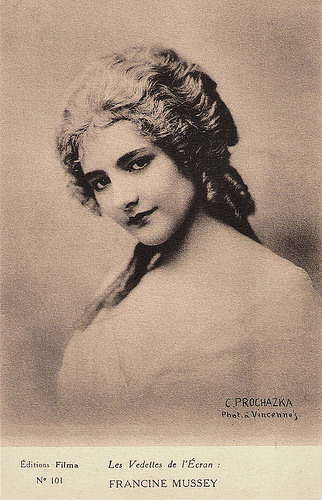
French postcard in the Les Vedettes de l'Écran series by Editions Filma, no. 101. Photo: C. Prochazka, Vincennes.
Fatal resolution
Francine Mussey was born in the 18th arrondissement of Paris as Marcelle Fromholt in 1897. She made her debut in the silent film L'épave/The Pavement (Lucien Lehmann, 1920), opposite actors Marcel Bonneau and Jean-François Martial.
In the French silent film La maison du mystère/The House of Mystery (Alexandre Volkoff, 1923), she co-starred with Russian film star Ivan Mozzhukhin and Charles Vanel . Henry Miyamoto at IMDb : "An art film shot as a serial. An imaginative wedding scene shot in silhouette, begins a tale of murder blackmail and romance covering a period of about 18 years, ending around 1923. The film had the MOMA audience breaking out into applause at the end of each chapter, starting from about chapter 3. At the June 28, 2003 showing at the Gramercy Theatre in New York, only 2 people left of the 150 people who came to see the film, and they came back to see the end of the film. A remarkable feat since the film ran over 7 hours."
Francine Mussey played in Germany opposite Ernst Verebes in Der Mann im Sattel/The Man in the Saddle (Manfred Noa, 1925). She appeared in the classic epic Napoléon vu par Abel Gance/Napoléon (Abel Gance, 1927) which tells the story of Napoleon's early years. The film runs for five and a half hours and is now seen as one of the greatest masterpieces of the silent cinema.
Mussey would go on to appear in a number of films throughout the 1920s and into the sound film era of the early 1930s. In Germany she played a supporting part in Die Frau die nicht nein sagen kann/The Woman Who Couldn't Say No (Fred Sauer, 1927) starring Lee Parry , Gustav Fröhlich and Hans Albers .
For Warner Bros, she co-starred with Jean Gabin in the sound film La foule hurle (Jean Daumerie, Howard Hawks, 1932). It was the alternate language version of The Crowd Roars (Howard Hawks, 1932) with James Cagney and Joan Blondell. Her last film was the French comedy L'âne de Buridan/Buridan's Donkey (Alexandre Ryder, 1932) starring René Lefèvre , Colette Darfeuil and Mona Goya .
Only 35, Francine Mussey died in 1933 in Paris. She committed suicide by ingesting poison. She was married to rowing ace Jean-Pierre Stock. Cinémagazine (April 1933): "The loss of her child a little more than a year ago, and the discouragement of this continual struggle that is cinema have led to this fatal Resolution".
Trailer La Maison du mystère/The House of Mystery (1923). Source: Flicker Alley (Vimeo).
Source: Cinémagazine (French), Wikipedia (French and English) and .

French postcard in the Les Vedettes de l'Écran series by Editions Filma, no. 101. Photo: C. Prochazka, Vincennes.
Fatal resolution
Francine Mussey was born in the 18th arrondissement of Paris as Marcelle Fromholt in 1897. She made her debut in the silent film L'épave/The Pavement (Lucien Lehmann, 1920), opposite actors Marcel Bonneau and Jean-François Martial.
In the French silent film La maison du mystère/The House of Mystery (Alexandre Volkoff, 1923), she co-starred with Russian film star Ivan Mozzhukhin and Charles Vanel . Henry Miyamoto at IMDb : "An art film shot as a serial. An imaginative wedding scene shot in silhouette, begins a tale of murder blackmail and romance covering a period of about 18 years, ending around 1923. The film had the MOMA audience breaking out into applause at the end of each chapter, starting from about chapter 3. At the June 28, 2003 showing at the Gramercy Theatre in New York, only 2 people left of the 150 people who came to see the film, and they came back to see the end of the film. A remarkable feat since the film ran over 7 hours."
Francine Mussey played in Germany opposite Ernst Verebes in Der Mann im Sattel/The Man in the Saddle (Manfred Noa, 1925). She appeared in the classic epic Napoléon vu par Abel Gance/Napoléon (Abel Gance, 1927) which tells the story of Napoleon's early years. The film runs for five and a half hours and is now seen as one of the greatest masterpieces of the silent cinema.
Mussey would go on to appear in a number of films throughout the 1920s and into the sound film era of the early 1930s. In Germany she played a supporting part in Die Frau die nicht nein sagen kann/The Woman Who Couldn't Say No (Fred Sauer, 1927) starring Lee Parry , Gustav Fröhlich and Hans Albers .
For Warner Bros, she co-starred with Jean Gabin in the sound film La foule hurle (Jean Daumerie, Howard Hawks, 1932). It was the alternate language version of The Crowd Roars (Howard Hawks, 1932) with James Cagney and Joan Blondell. Her last film was the French comedy L'âne de Buridan/Buridan's Donkey (Alexandre Ryder, 1932) starring René Lefèvre , Colette Darfeuil and Mona Goya .
Only 35, Francine Mussey died in 1933 in Paris. She committed suicide by ingesting poison. She was married to rowing ace Jean-Pierre Stock. Cinémagazine (April 1933): "The loss of her child a little more than a year ago, and the discouragement of this continual struggle that is cinema have led to this fatal Resolution".
Trailer La Maison du mystère/The House of Mystery (1923). Source: Flicker Alley (Vimeo).
Source: Cinémagazine (French), Wikipedia (French and English) and .
Published on August 28, 2017 22:00
August 27, 2017
Nicole Besnard (1928-2017)
French actress Nicole Besnard died on 20 August 2017. She appeared in several French films of the 1950s, including the classic La Beauté du diable (1950) by René Clair.
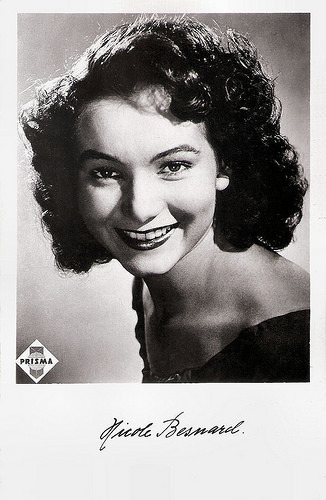
German postcard. Photo: Prisma. Publicity still for La Beauté du diable/Beauty and the Devil (René Clair, 1950).
Beauty and the Devil
Nicole Suzanne Fernande Besnard was born in 1928 in Grenoble, France. After spending part of her childhood in Grenoble, her family moved to Paris during the war.
She became a student of Beatrix Dussane at the Conservatory of dramatic art of Paris. Besnard also entered at the Cours Simon.
She made her film debut in the girls reformatory drama Au royaume des cieux/The Sinners (Julien Duvivier, 1949) with Serge Reggiani .
Then followed the Faust adaptation La Beauté du diable/Beauty and the Devil (René Clair, 1950), with Gérard Philipe and Michel Simon alternating as Faust and Mephistoles. Besnard played the adorable gypsy girl Marguerite, who finally redeems Faust.
Her other films include Ils étaient cinq/They Were Five (Jacques Pinoteau, 1951) with Jean Carmet, Leguignon guérisseur/Leguinon, Healer (Maurice Labro, 1954) and the German musical An der schönen blauen Donau/At The Beautiful Blue Danube (Hans Schweikart, 1955) with Hardy Krüger .
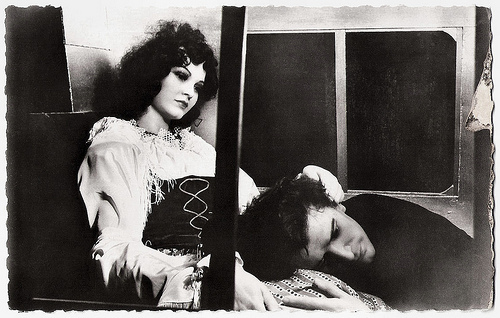
French postcard by Editions P.I. / Editions du Musée Grévin., Paris, no. 4. Publicity still for La Beauté du diable/Beauty and the Devil (René Clair, 1950) with Gérard Philipe . Captions: Voyage de noces a Venise (Honeymoon in Venice).
Passion for antique furniture
In 1958, Nicole Besnard abandoned the cinema and the theatre to devote herself to her passion for antique furniture.
Her final film was the filmed operetta L'Auberge en folie/The inn gone mad (Pierre Chevalier, 1957) with Basque singer Rudi Hirigoyen and Geneviève Kervine . Besnard only had a small supporting part in it.
Besnard went to work for an antique dealer in Paris. She had a daughter, Brigitte, with Ole Fredrik Christian Bornemann, a lawyer, journalist and author of detective novels.
Nicole Besnard died of lung problems in Porspoder in Britany, where she had lived the past 15 years, to be close to her daughter. She was 89.
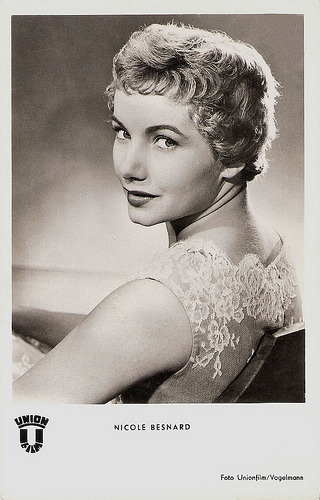
German postcard by Kunst und Bild, Berlin, no. A 1309. Photo: Unionfilm / Vogelmann. Publicity still for An der schönen blauen Donau/At The Beautiful Blue Danube (Hans Schweikart, 1955).
Sources: Wikipedia (French) and .

German postcard. Photo: Prisma. Publicity still for La Beauté du diable/Beauty and the Devil (René Clair, 1950).
Beauty and the Devil
Nicole Suzanne Fernande Besnard was born in 1928 in Grenoble, France. After spending part of her childhood in Grenoble, her family moved to Paris during the war.
She became a student of Beatrix Dussane at the Conservatory of dramatic art of Paris. Besnard also entered at the Cours Simon.
She made her film debut in the girls reformatory drama Au royaume des cieux/The Sinners (Julien Duvivier, 1949) with Serge Reggiani .
Then followed the Faust adaptation La Beauté du diable/Beauty and the Devil (René Clair, 1950), with Gérard Philipe and Michel Simon alternating as Faust and Mephistoles. Besnard played the adorable gypsy girl Marguerite, who finally redeems Faust.
Her other films include Ils étaient cinq/They Were Five (Jacques Pinoteau, 1951) with Jean Carmet, Leguignon guérisseur/Leguinon, Healer (Maurice Labro, 1954) and the German musical An der schönen blauen Donau/At The Beautiful Blue Danube (Hans Schweikart, 1955) with Hardy Krüger .

French postcard by Editions P.I. / Editions du Musée Grévin., Paris, no. 4. Publicity still for La Beauté du diable/Beauty and the Devil (René Clair, 1950) with Gérard Philipe . Captions: Voyage de noces a Venise (Honeymoon in Venice).
Passion for antique furniture
In 1958, Nicole Besnard abandoned the cinema and the theatre to devote herself to her passion for antique furniture.
Her final film was the filmed operetta L'Auberge en folie/The inn gone mad (Pierre Chevalier, 1957) with Basque singer Rudi Hirigoyen and Geneviève Kervine . Besnard only had a small supporting part in it.
Besnard went to work for an antique dealer in Paris. She had a daughter, Brigitte, with Ole Fredrik Christian Bornemann, a lawyer, journalist and author of detective novels.
Nicole Besnard died of lung problems in Porspoder in Britany, where she had lived the past 15 years, to be close to her daughter. She was 89.

German postcard by Kunst und Bild, Berlin, no. A 1309. Photo: Unionfilm / Vogelmann. Publicity still for An der schönen blauen Donau/At The Beautiful Blue Danube (Hans Schweikart, 1955).
Sources: Wikipedia (French) and .
Published on August 27, 2017 22:00
Paul van Yperen's Blog
- Paul van Yperen's profile
- 13 followers
Paul van Yperen isn't a Goodreads Author
(yet),
but they
do have a blog,
so here are some recent posts imported from
their feed.



